Top 25 Colorful Tulips: A Rainbow in Your Garden
Explore 25 colorful tulip s, from classic hybrids to rare species. Learn how to design, plant, and fun facts for a colorful spring garden.

Colorful Tulips: With their vibrant hues and elegant forms, Tulips have captivated gardeners and flower enthusiasts for centuries. These stunning spring blooms offer a kaleidoscope of colors that can transform any garden into a breathtaking spectacle. From the deepest purples to the brightest yellows, tulips provide an unparalleled range of shades that can suit any garden design or personal preference.
The history of tulip cultivation is as colorful as the flowers themselves. Originating in Central Asia, tulips made their way to Europe in the 16th century, sparking “Tulip Mania” in the Netherlands[1] – a period of economic frenzy where tulip bulbs were traded for astronomical sums. Today, the Netherlands remains the world’s largest producer of tulips, with fields of these colorful blooms drawing tourists from around the globe.
Jump to:
25 Colorful Tulips
Color plays a crucial role in tulip selection, not just for aesthetic reasons but also for the emotions and atmosphere they can evoke in a garden. Bright reds and oranges can create a sense of warmth and Energy, while soft Pinks and whites can contribute to a more serene and romantic setting. The choice of tulip colors can dramatically influence the overall mood of your outdoor space.
This comprehensive guide will explore the top 25 colorful tulips that can bring vibrancy and life to your garden. From classic favorites to unique varieties, you’ll discover many options for your gardening style and color preferences. Let’s embark on this colorful journey through the world of tulips!
1. Angelique (Tulipa ‘Angelique’)
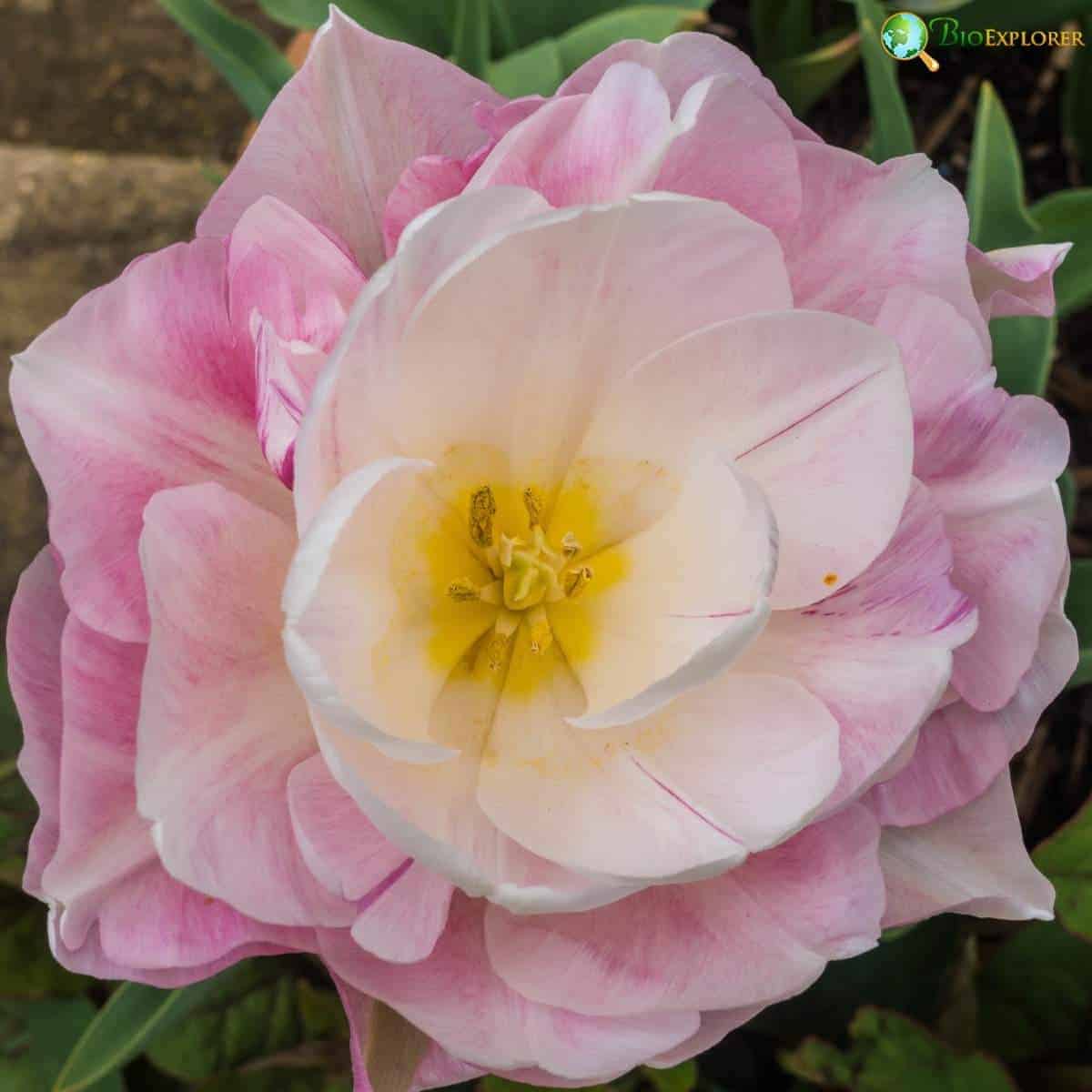
Angelique is a stunning double-flowered tulip that resembles a delicate Peony. This hybrid tulip is prized for its soft, romantic appearance. It is a favorite among gardeners seeking an elegant, pastel touch in their spring Gardens.
Colors available: Primarily soft pink, with outer petals sometimes hinting at white or pale green.
Fun facts:
- Due to their full, lush blooms, Angelique tulips are often called “peony-flowered” tulips.
- They were first bred in the Netherlands in 1959 and have been popular ever since.
- These tulips are excellent for cut flower arrangements, lasting up to 10 days in a vase.
Angelique tulips typically grow to 16-18 inches (40-45 cm), making them perfect for middle positions in garden beds or Borders. They bloom mid to late spring, offering a soft contrast to bolder tulip varieties.
2. Queen of Night (Tulipa ‘Queen of Night’)
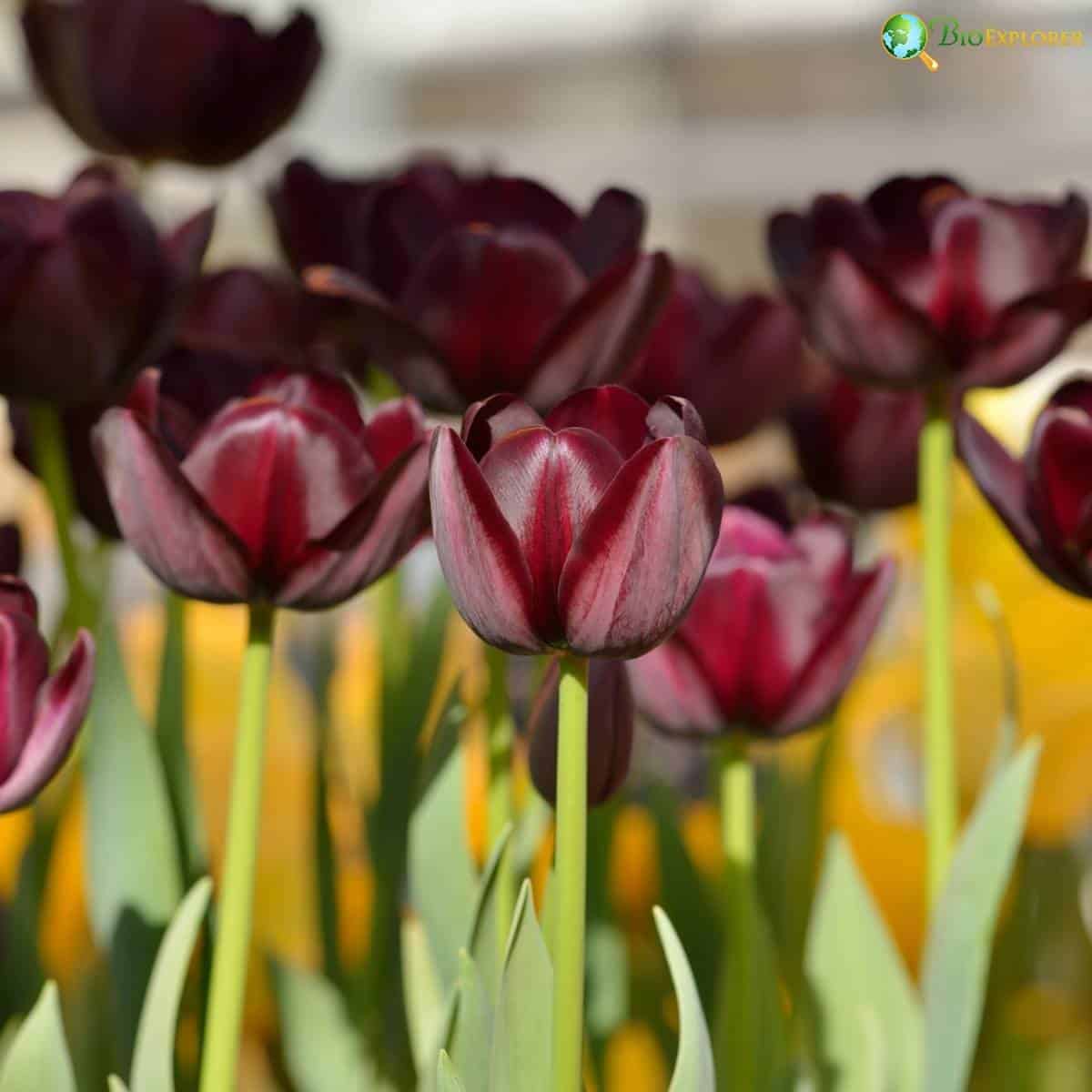
Queen of Night is a striking single late tulip known for its deep, dark coloration. This hybrid tulip stands out in any garden setting, dramatically contrasting lighter-colored flowers and foliage.
Colors available: Deep purple, so dark it appears almost black in certain lights.
Fun facts:
- Despite its name, the Queen of Night tulip is not truly black. In bright sunlight, you can see its deep purple hues.
- It was first introduced in 1944 and has been a popular choice for dramatic garden designs.
- The flowers can reach up to 24 inches (60 cm) in height, making them true garden royalty.
Queen of Night tulips typically bloom in late spring, extending the tulip season with their majestic presence. Their tall stems and large, cup-shaped flowers make them ideal for the back of borders or as a focal point in garden beds.
3. Tulipa sylvestris (Wild Tulip)
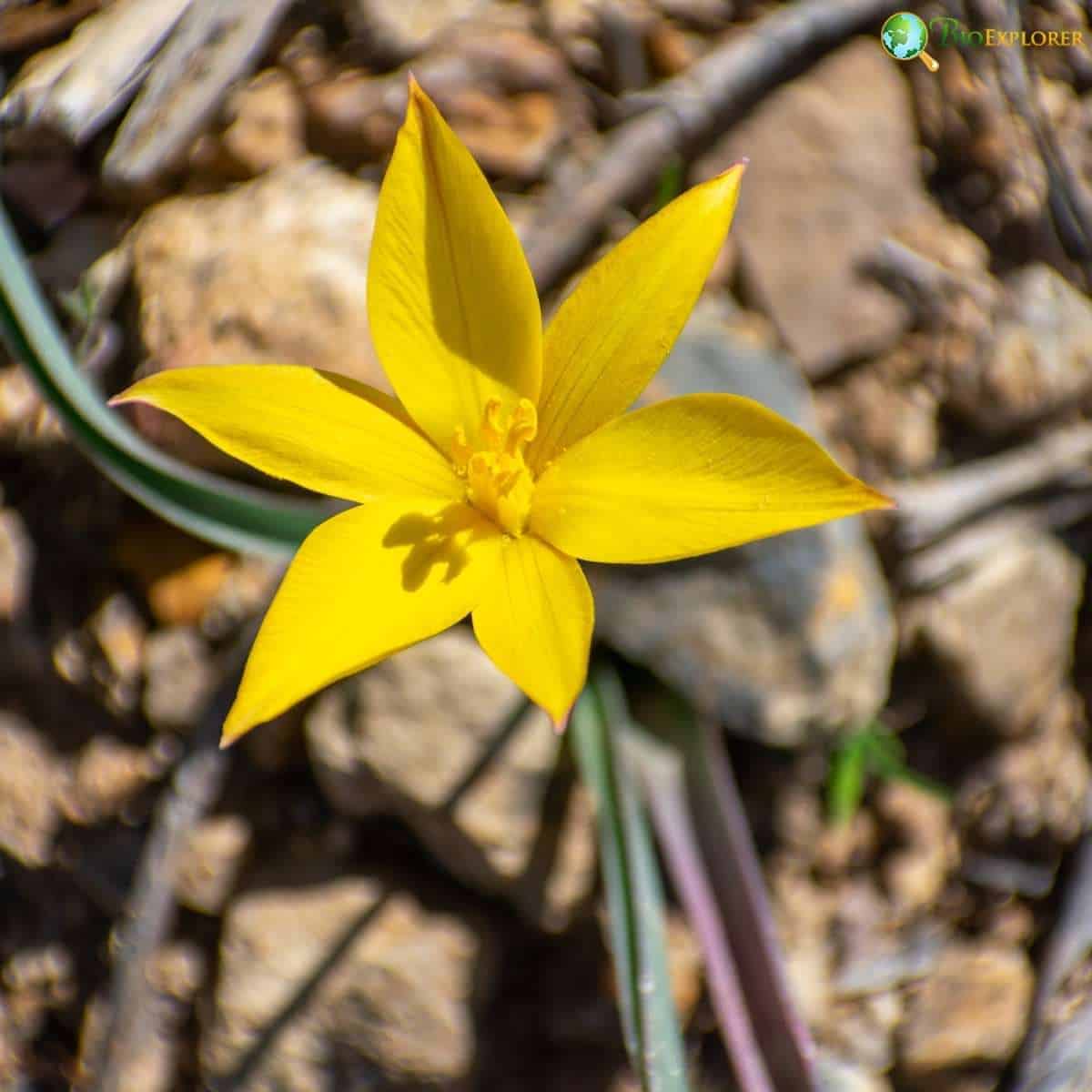
| Kingdom | Order | Family | Genus | Species |
|---|---|---|---|---|
| Plantae | Liliales | Liliaceae | Tulipa | Tulipa sylvestris |
Tulipa sylvestris, commonly known as the Wild Tulip or Woodland Tulip, is a species of tulip native to Europe and parts of North Africa. This charming, naturalizing tulip brings a touch of wildflower elegance to gardens and woodland settings[2].
Colors available: Primarily bright yellow, sometimes with a subtle green tinge on the outer petals.
Fun facts:
- Tulipa sylvestris is one of the few tulip species native to Europe.
- It’s been cultivated since the 16th century and was popular in English gardens during the Tudor period.
- Unlike many hybrid tulips, T. sylvestris has a sweet, light fragrance.
- The flowers nod or droop slightly before opening fully, giving them a naturalistic, wild appearance.
4. Flaming Parrot (Tulipa ‘Flaming Parrot’)
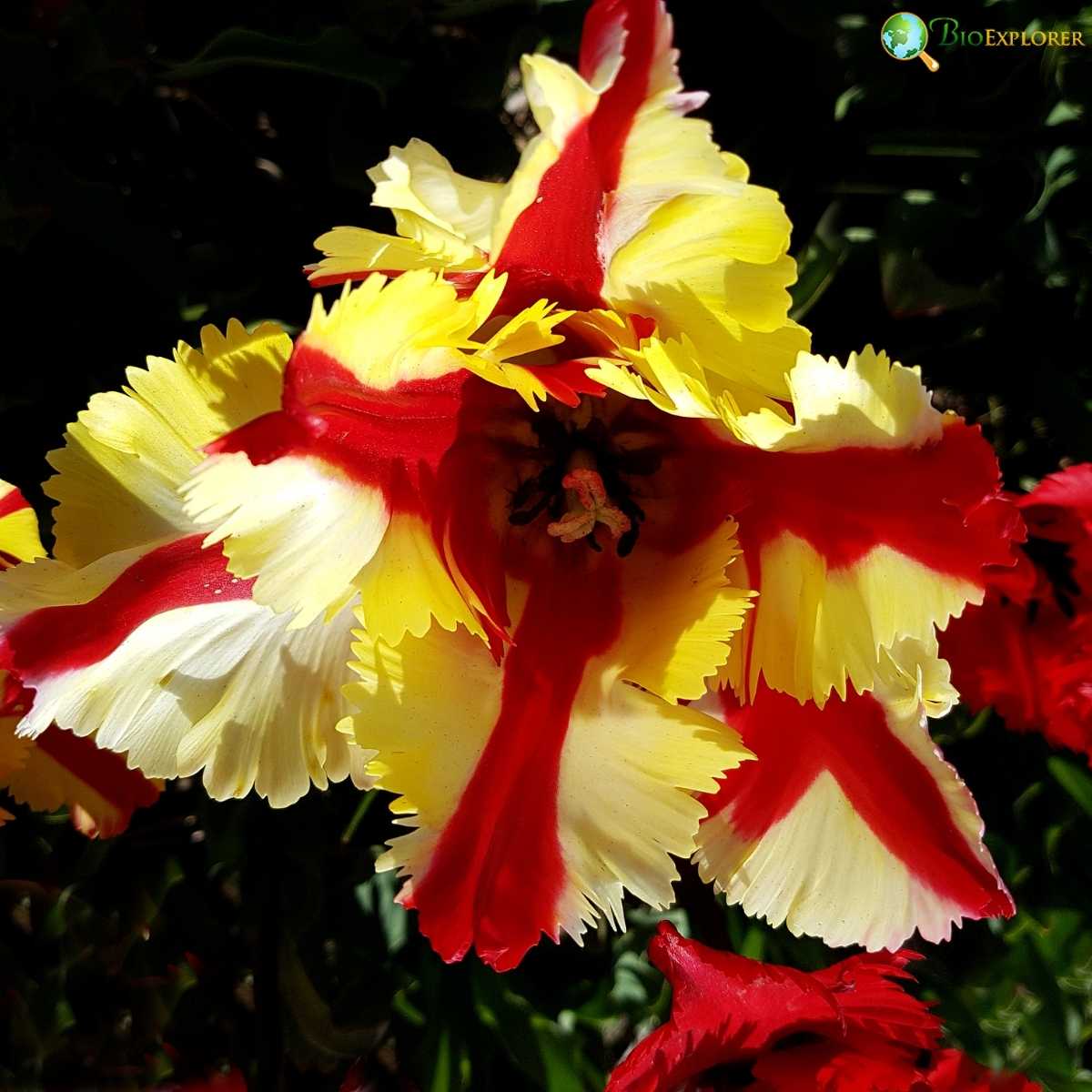
Flaming Parrot is a spectacular parrot tulip group member known for its dramatically fringed and ruffled petals. This eye-catching hybrid tulip brings a sense of glitz and excitement to spring gardens with its unique form and vibrant coloration.
Colors available: Primarily red and yellow, with flames and streaks of both colors intermingling on each petal.
Fun facts:
- Parrot tulips got their name from their feather-like, ruffled petals that resemble a parrot’s plumage.
- Flaming Parrot tulips can grow up to 22 inches (55 cm) tall, making them true standouts in the garden.
- The unusual shape of parrot tulips is caused by a naturally occurring virus that affects the flower’s development.
- Each Flaming Parrot flower can measure up to 6 inches (15 cm) across when fully open.
5. Tulipa humilis (Dwarf Tulip)
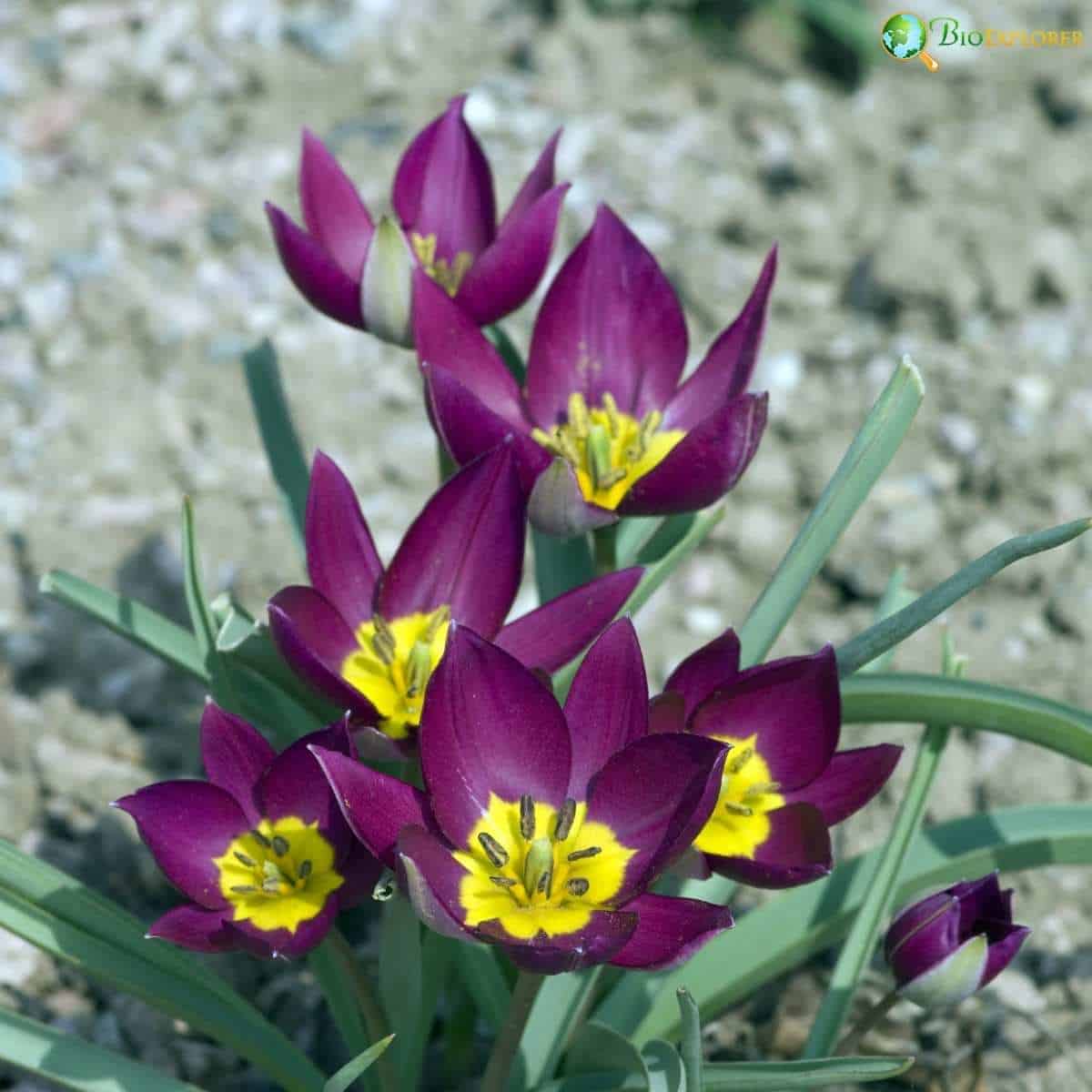
Tulipa humilis, commonly known as the Dwarf Tulip or Humble Tulip, is a charming species of tulip native to parts of the Middle East and Central Asia. This diminutive beauty brings a touch of delicate elegance to rock gardens, borders, and containers.
Colors available: Magenta-pink, but cultivars can range from white to deep purple, often with a contrasting yellow or white base.
Fun facts:
- Despite its name, Tulipa humilis can vary in height from 3 to 8 inches (7.5 to 20 cm), depending on the growing conditions.
- Each bulb can produce multiple flower stems, creating a more abundant display than larger tulips.
- The flowers open wide in sunlight, revealing a contrasting center that attracts pollinators.
- Tulipa humilis is one of the earliest tulips to bloom, often appearing alongside Crocuses in early spring.
6. Tulipa agenensis
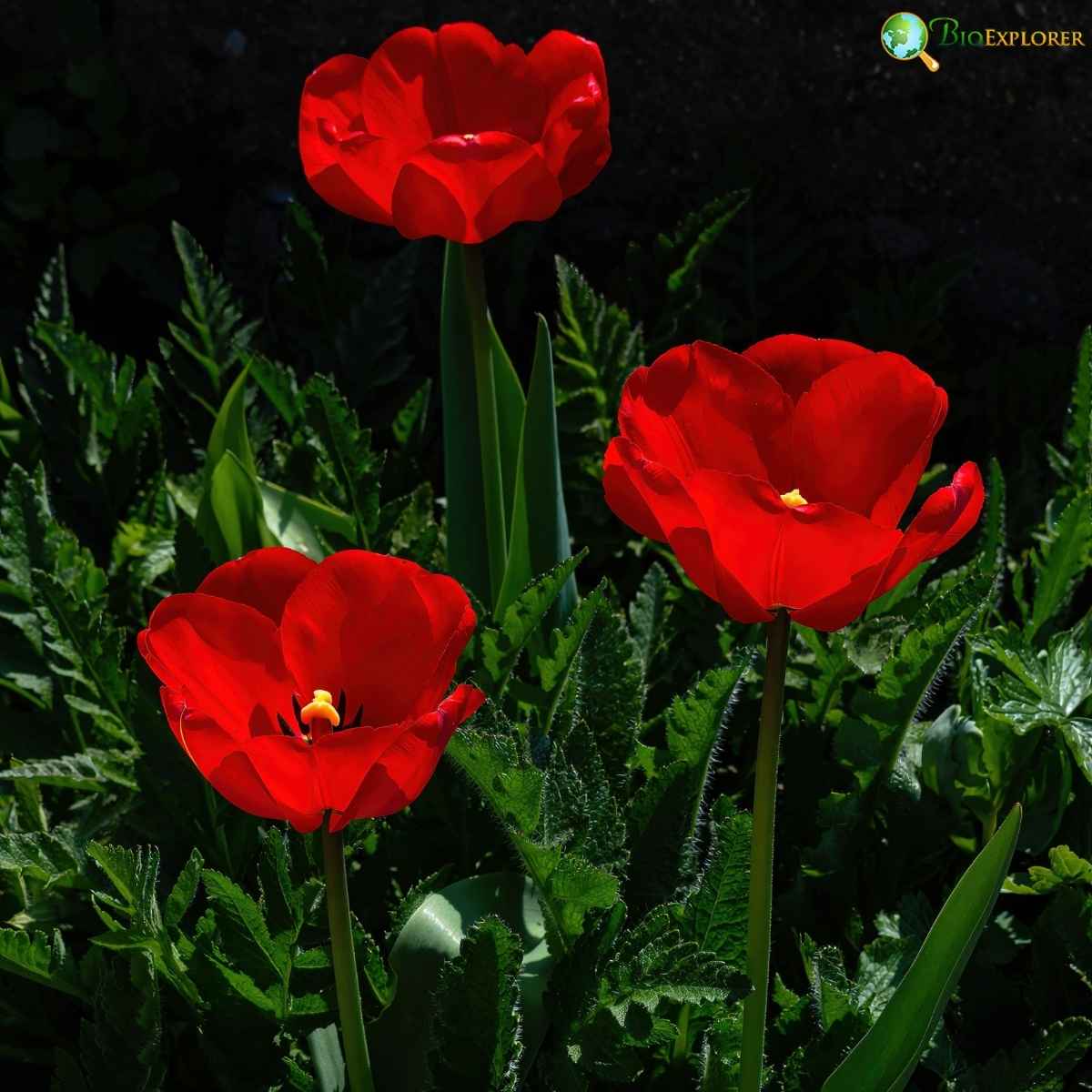
Tulipa agenensis, sometimes called the Eyed Tulip or Persian Tulip, is a striking species of tulip native to parts of the Middle East and Central Asia. This wild tulip brings exotic beauty to gardens with its vibrant coloration and distinctive markings[3].
Colors available: Primarily bright red with a distinctive black base, often with a yellow edge around the black center.
Fun facts:
- Tulipa agenensis is one of the parent species of many modern tulip hybrids.
- It’s been cultivated since the 16th century and played a role in the famous “Tulip Mania” of the Dutch Golden Age.
- The species name “agenensis” is believed to be a misnomer, as the tulip is not native to Agen, France, as originally thought.
- In optimal conditions, it can naturalize and spread over time, creating stunning drifts of color.
7. Tulipa clusiana (Lady Tulip)
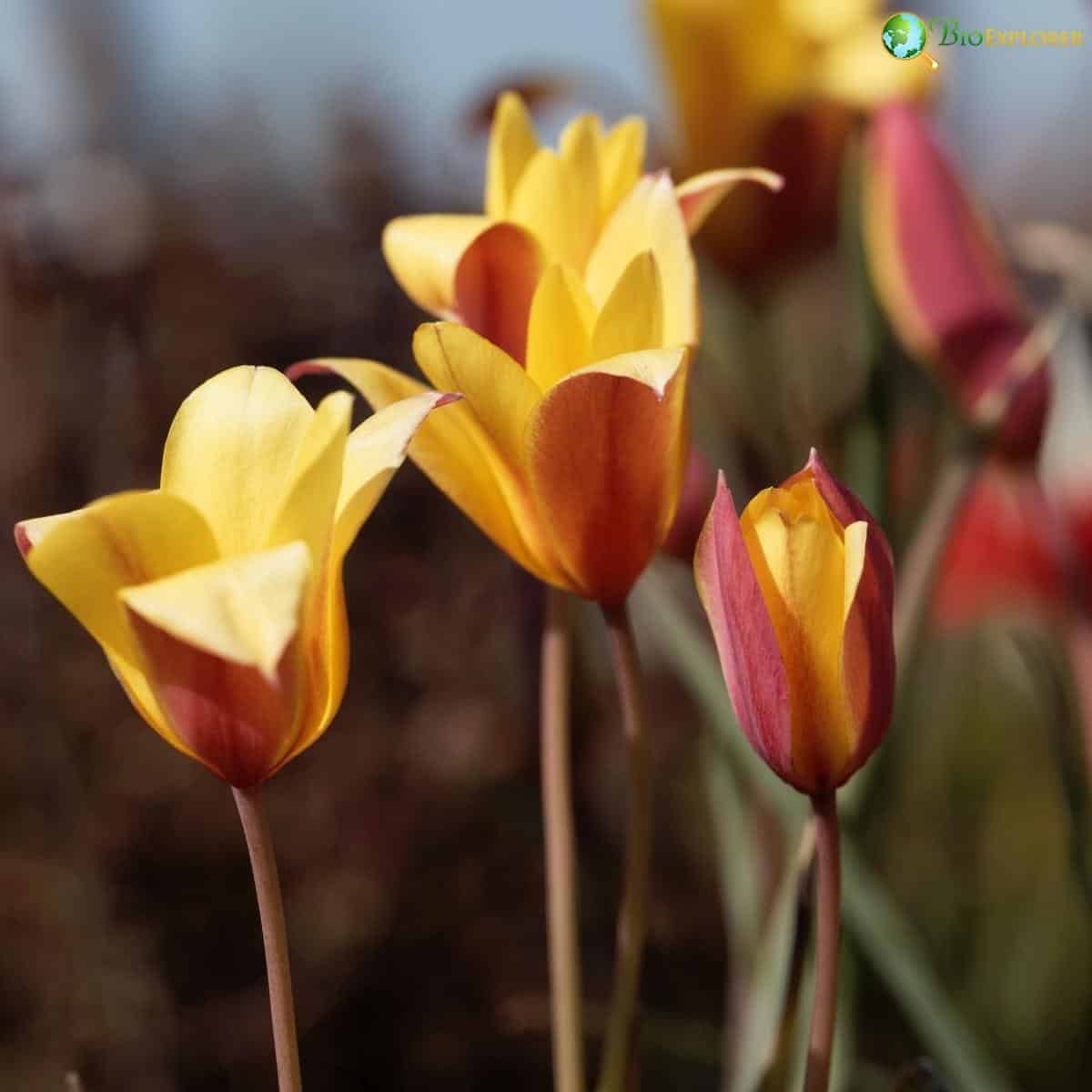
Tulipa clusiana, commonly known as the Lady Tulip[4] or Candy Tulip, is a charming species of tulip native to the Middle East and Central Asia. This elegant and refined tulip brings delicate beauty to spring gardens with its slender form and distinctive coloration.
Colors available: White petals with pink or red exterior stripes, though varieties can range from solid yellow to deep red.
Fun facts:
- Tulipa clusiana is named after the 16th-century Flemish botanist Charles de l’Écluse (Carolus Clusius), who significantly popularized tulips in Europe.
- It’s one of the oldest cultivated tulip species grown in gardens since the early 17th century.
- The flowers close at night and on cloudy days, reopening when exposed to sunlight.
- Unlike many tulips, T. clusiana often naturalizes well in warmer climates.
8. Black Parrot (Tulipa ‘Black Parrot’)
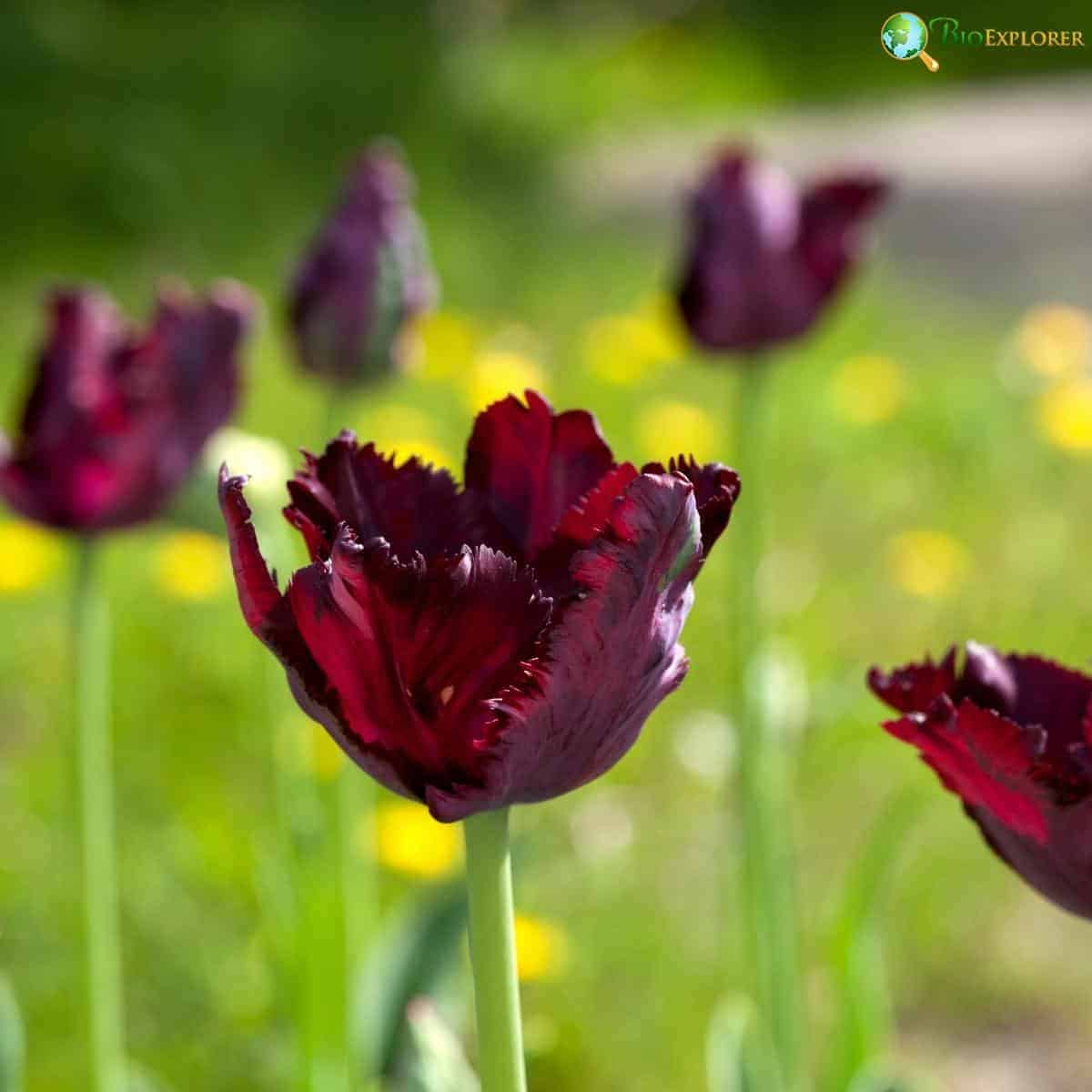
Black Parrot is a stunning parrot tulip group member known for its deeply feathered petals and unusual coloration. This exotic-looking hybrid tulip brings a touch of drama and sophistication to spring gardens with its unique form and rich, dark hues.
Colors available: Deep purple, so dark it appears almost black, sometimes with a subtle green edge to the petals.
Fun facts:
- Black Parrot tulips were first introduced in 1937 and have captivated gardeners ever since[5].
- The feathered, curled petals are caused by a virus that affects the flower’s development. Still, this trait has been stabilized through careful breeding.
- Each flower can measure up to 5 inches (12.5 cm) across when fully open.
- Despite their name, Black Parrot tulips are not truly black but a very deep purple that appears black in certain lights.
9. Tulipa kaufmanniana (Waterlily Tulip)
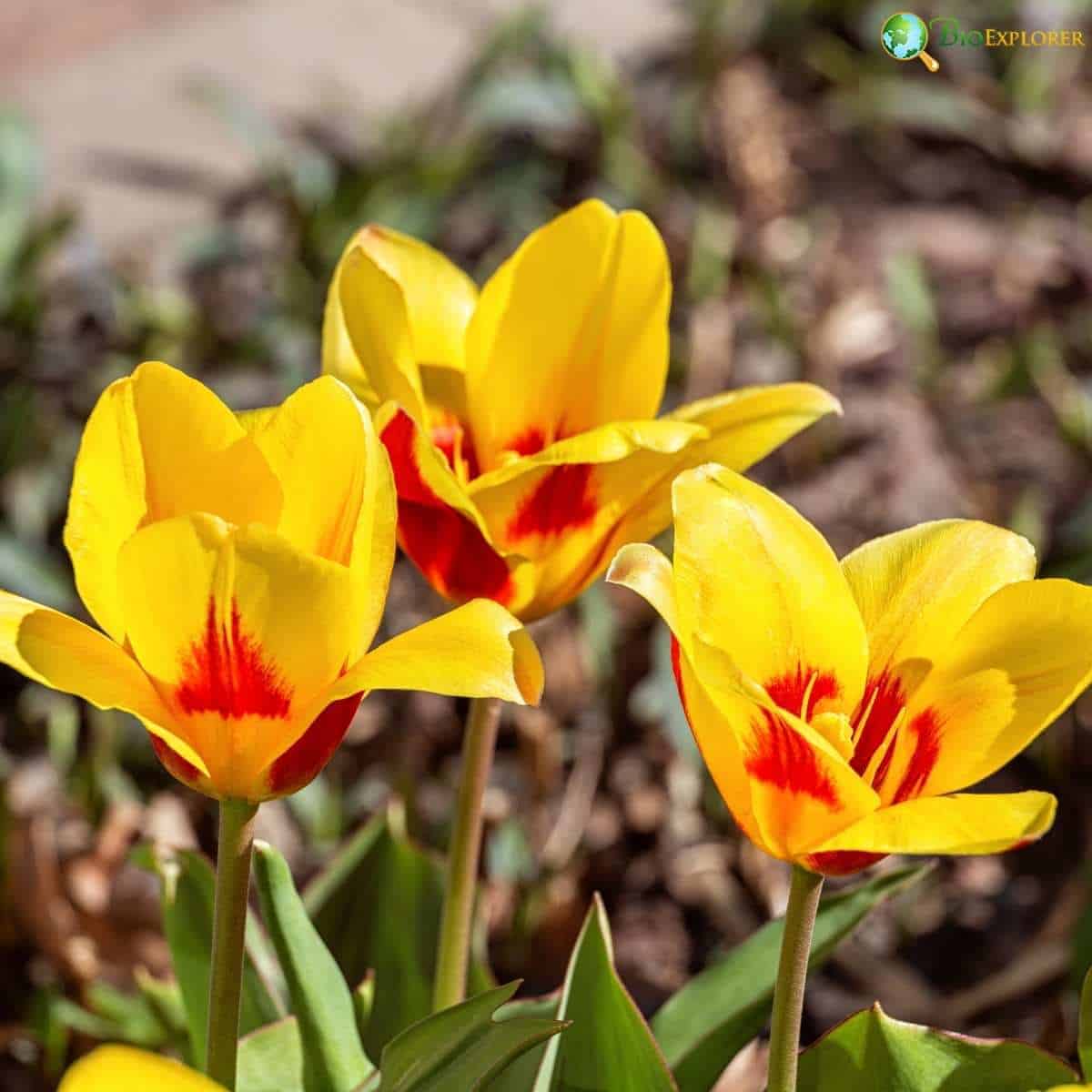
Tulipa kaufmanniana, commonly known as the Waterlily Tulip, is a charming tulip native to Central Asia. This early-blooming tulip is prized for its unique flower shape and naturalization ability in garden settings[6].
Cream or yellow with red or pink outer petals, though cultivars can range from pure white to deep red.
Fun facts:
- Tulipa kaufmanniana is one of the earliest tulips to bloom, often flowering alongside crocuses in early spring.
- The flowers open wide in sunlight, resembling Water Lilies, hence their common name.
- This species is one of the parents of the Greigii tulip group, known for their mottled foliage.
- In favorable conditions, T. kaufmanniana can naturalize and spread over time, creating beautiful drifts of color.
10. Purple Prince (Tulipa ‘Purple Prince’)
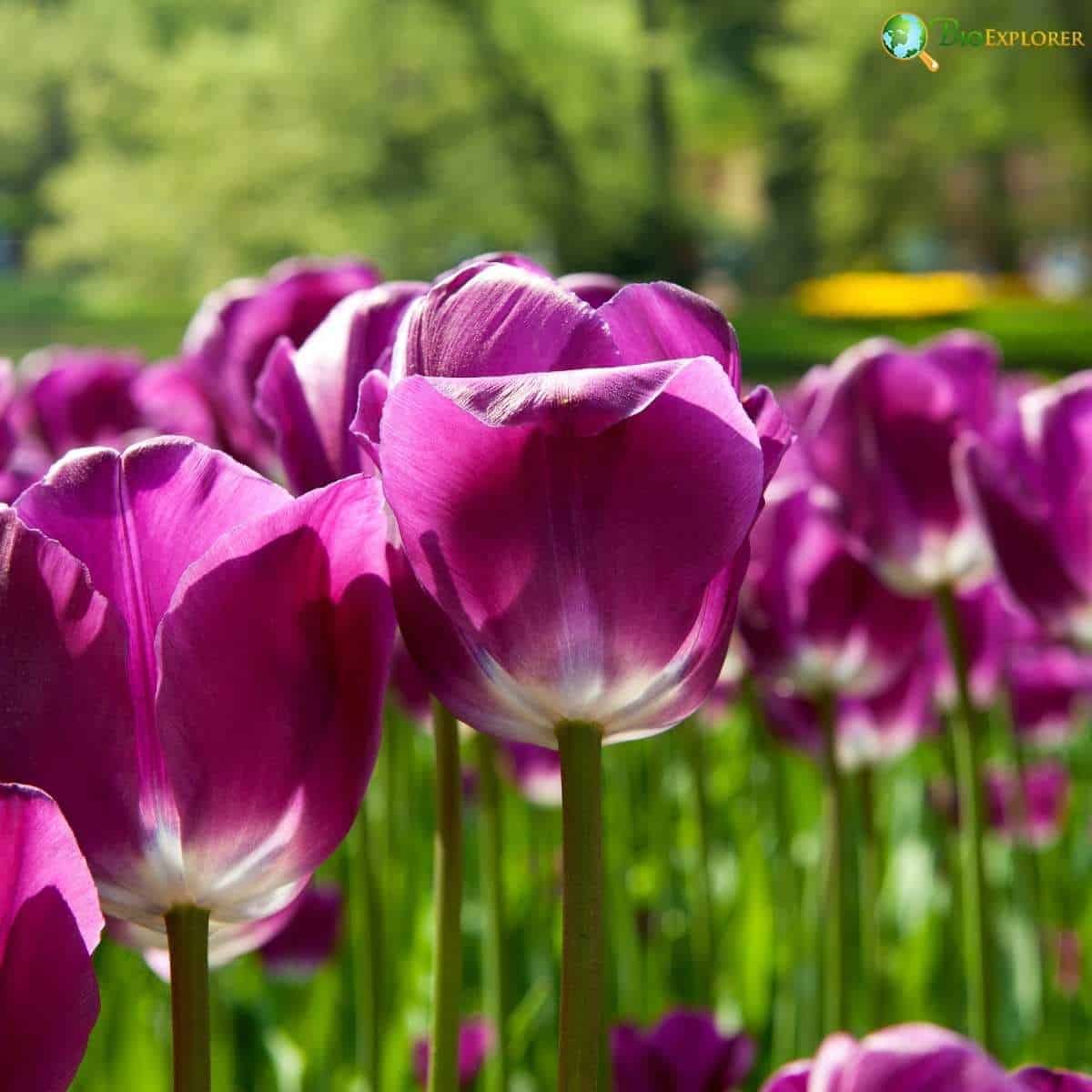
Purple Prince is a striking single early tulip known for its rich, deep purple color and robust growth habit. This hybrid tulip brings a regal presence to spring gardens with its vibrant hue and classic tulip shape.
Colors available: Deep purple with a slight blue sheen, sometimes with a darker base inside the flower.
Fun facts:
- Purple Prince tulips are among the earliest hybrid tulips to bloom, often flowering early to mid-spring.
- The flowers have a slight sheen that gives them an almost metallic appearance in certain lights.
- This variety is known for its strong stems, making it resistant to wind and rain damage.
- Purple Prince tulips are excellent for forcing indoors, allowing gardeners to enjoy their vibrant color even earlier in the season.
11. Tulipa tarda (Late Tulip)
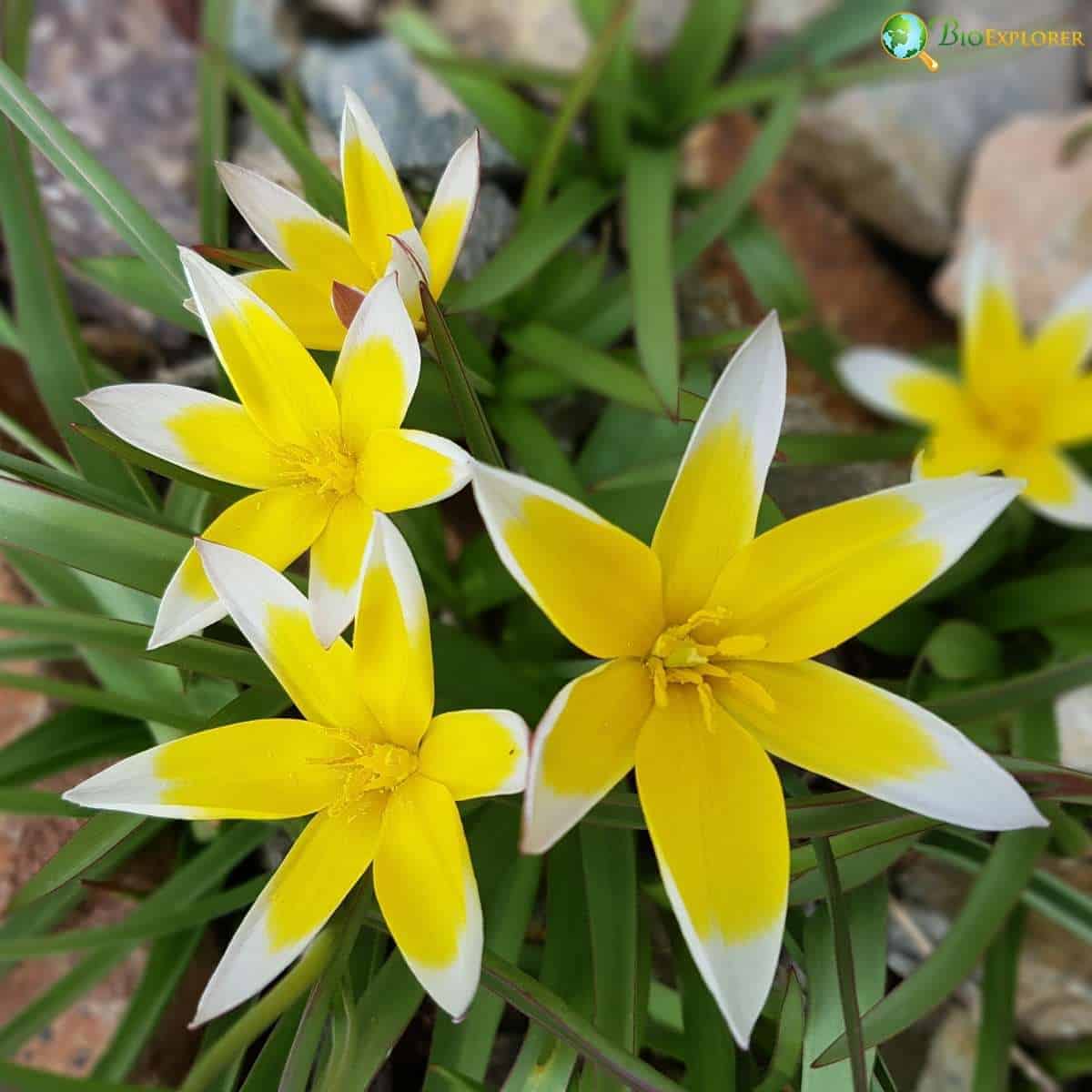
Tulipa tarda, also known as the Late Tulip or Tarda Tulip[7], is a charming species of tulip native to Central Asia. This low-growing, multi-flowered tulip brings a cheerful and naturalistic touch to spring gardens with its star-shaped blooms.
Colors available: White petals with a bright yellow center, creating a distinctive star-like appearance.
Fun facts:
- Despite its common name, “Late Tulip”, T. tarda is one of the earlier species of tulips to bloom.
- Each bulb can produce up to five flowers, creating a more abundant display than many larger tulips.
- Tulipa tarda is known for its excellent naturalizing ability, spreading slowly to form attractive colonies over time.
- The flowers open wide in sunlight, closing at night and on cloudy days.
12. Estella Rijnveld (Tulipa ‘Estella Rijnveld’)
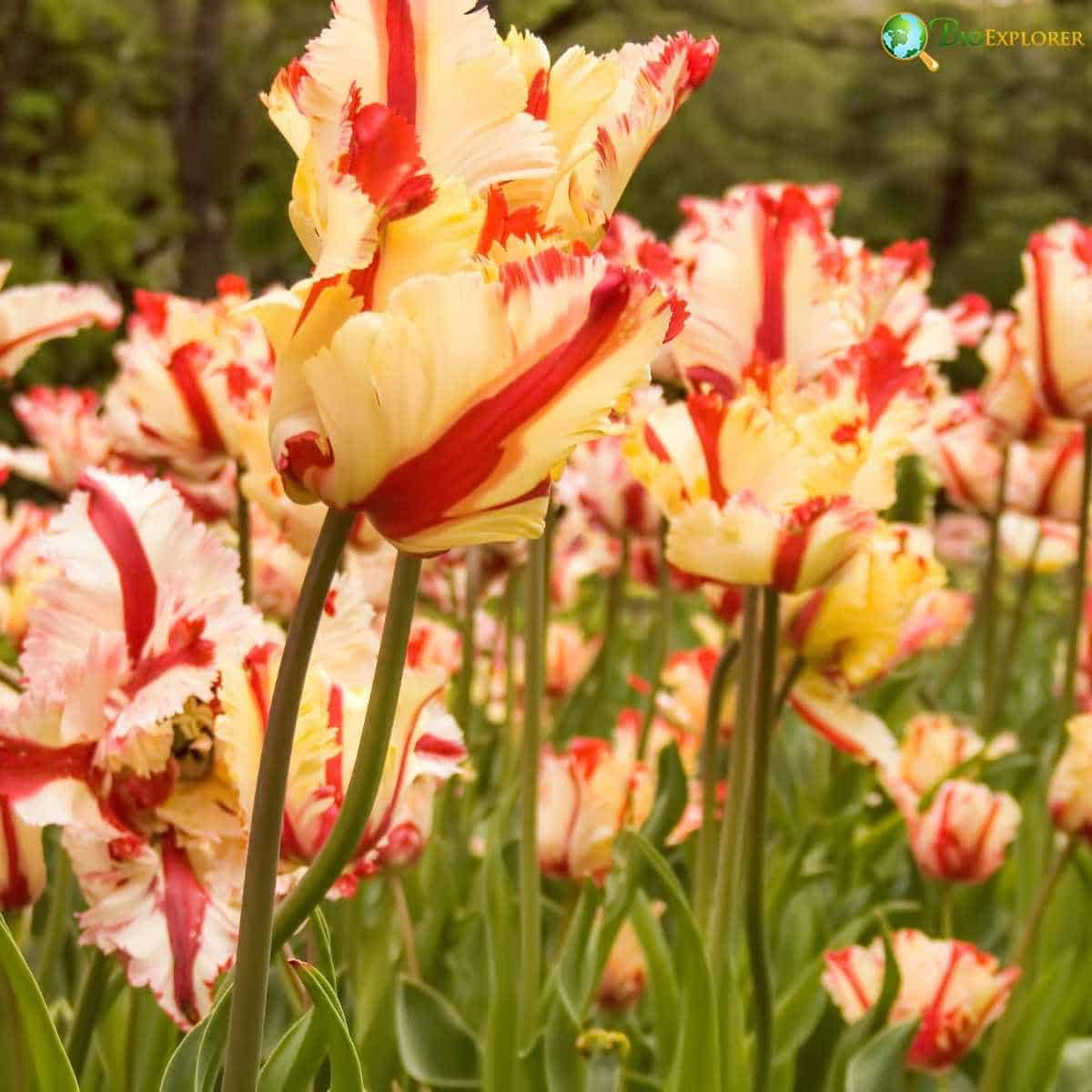
Estella Rijnveld is a stunning parrot tulip known for its dazzling, feathered petals and striking color combination. This eye-catching hybrid tulip brings a sense of whimsy and drama to spring gardens with its unique form and vivid coloration.
Colors available: White base with bold red striping and feathering. The red can range from cherry to deep crimson, creating a candy-cane-like effect.
Fun facts:
- Estella Rijnveld was introduced in 1954 and has been a favorite among gardeners and floral designers ever since.
- The cultivar is named after Estella Rijnveld, a prominent Dutch bulb-growing family member.
- Like all parrot tulips, its frilly petals are caused by a virus, but this trait has been stabilized through careful breeding.
- Each flower can measure up to 4-5 inches (10-12.5 cm) across when fully open.
13. Tulipa urumiensis (Golden Tulip)
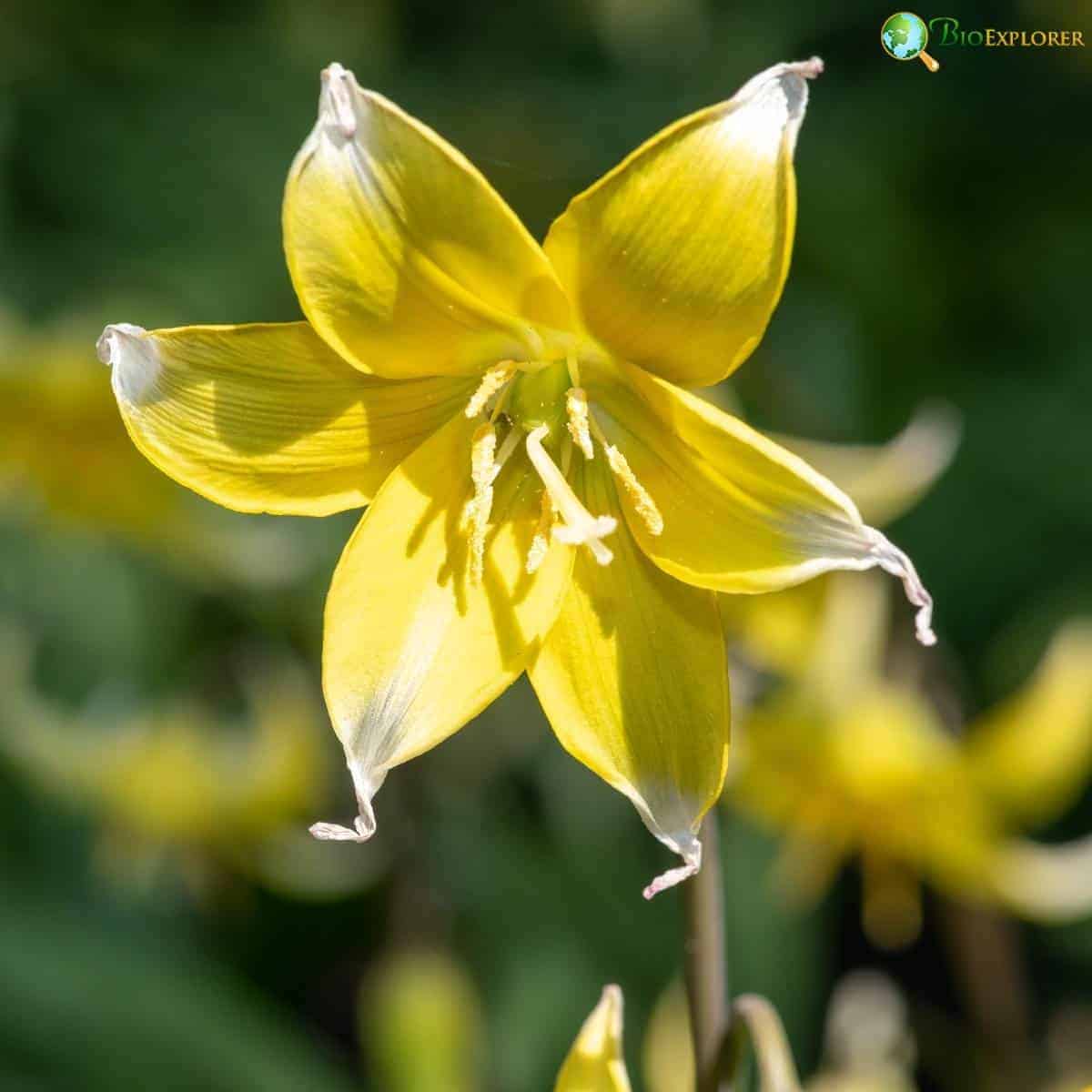
Tulipa urumiensis, commonly known as the Golden Tulip or Urumia Tulip, is a charming species of tulip native to Iran and Turkey. This petite beauty brings a burst of sunny color to spring gardens with its bright, Star-Shaped Flowers.
Colors available: Bright golden-yellow, sometimes with a slight green tinge on the outer petals.
Fun facts:
- Tulipa urumiensis is named after Lake Urmia in Iran[8], where it was first discovered.
- Despite its small size, each bulb can produce multiple flower stems, creating a more abundant display than many larger tulips.
- The flowers open wide in sunlight, forming perfect stars, and close at night or in cloudy weather.
- It’s one of the earliest tulips to bloom, often flowering alongside crocuses and early daffodils.
14. Red Riding Hood (Tulipa greigii ‘Red Riding Hood’)
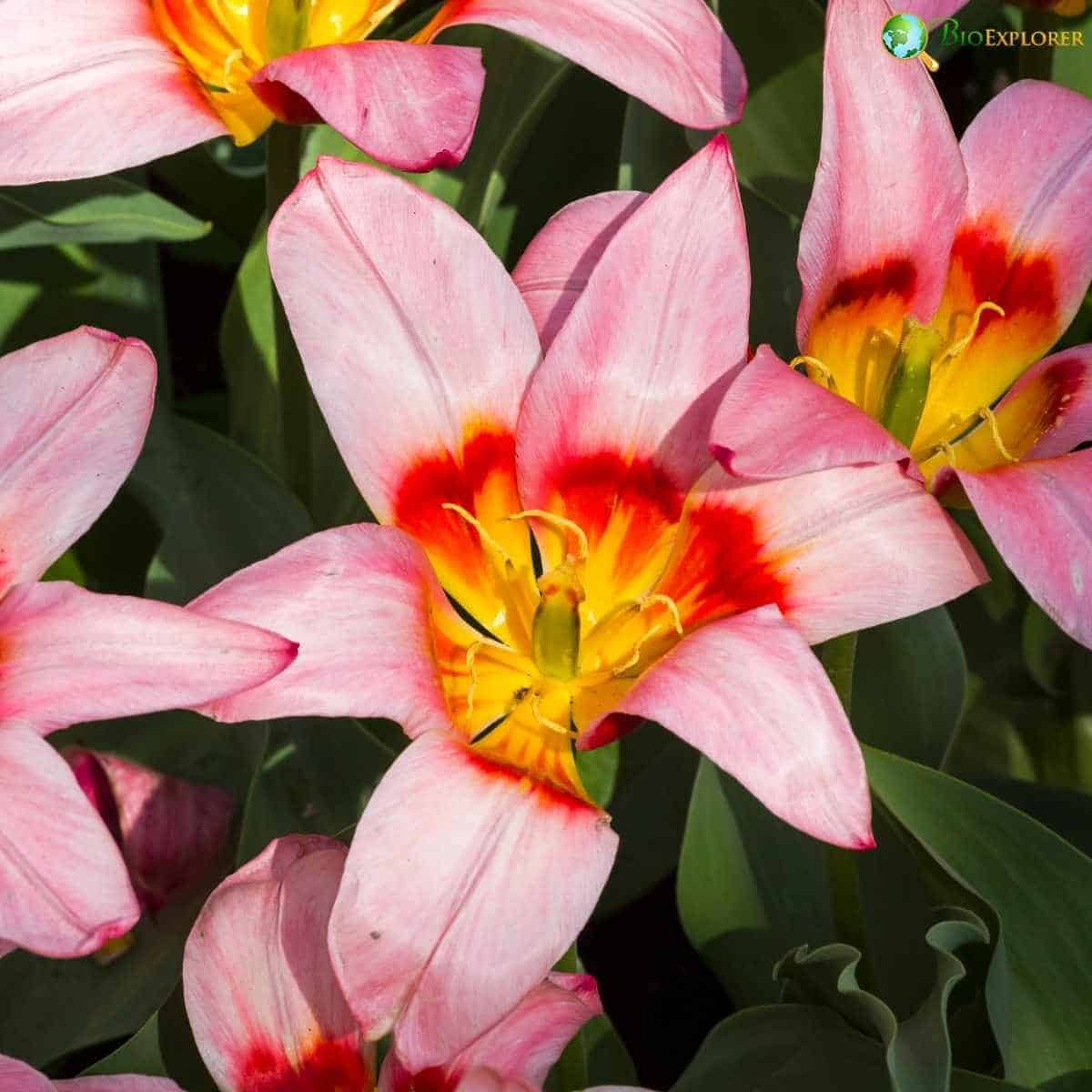
Red Riding Hood is a captivating cultivar of the Greigii tulip group, known for its vibrant red flowers and distinctively mottled foliage. This charming tulip brings a touch of whimsy and color to spring gardens with its compact form and eye-catching features.
Colors available: Bright scarlet red flowers with a black base, sometimes showing a yellow edge.
Fun facts:
- Red Riding Hood tulips are named after the famous fairy tale character, likely due to their bright red color.
- The leaves of Red Riding Hood tulips are as striking as the flowers, with distinctive purple-brown mottling on a green background.
- Greigii tulips, including Red Riding Hood, are known for their ability to perennialize better than many other tulip types[9].
- These tulips are often among the first to bloom in spring, bringing early color to the garden.
15. Tulipa orphanidea (Greek Tulip)
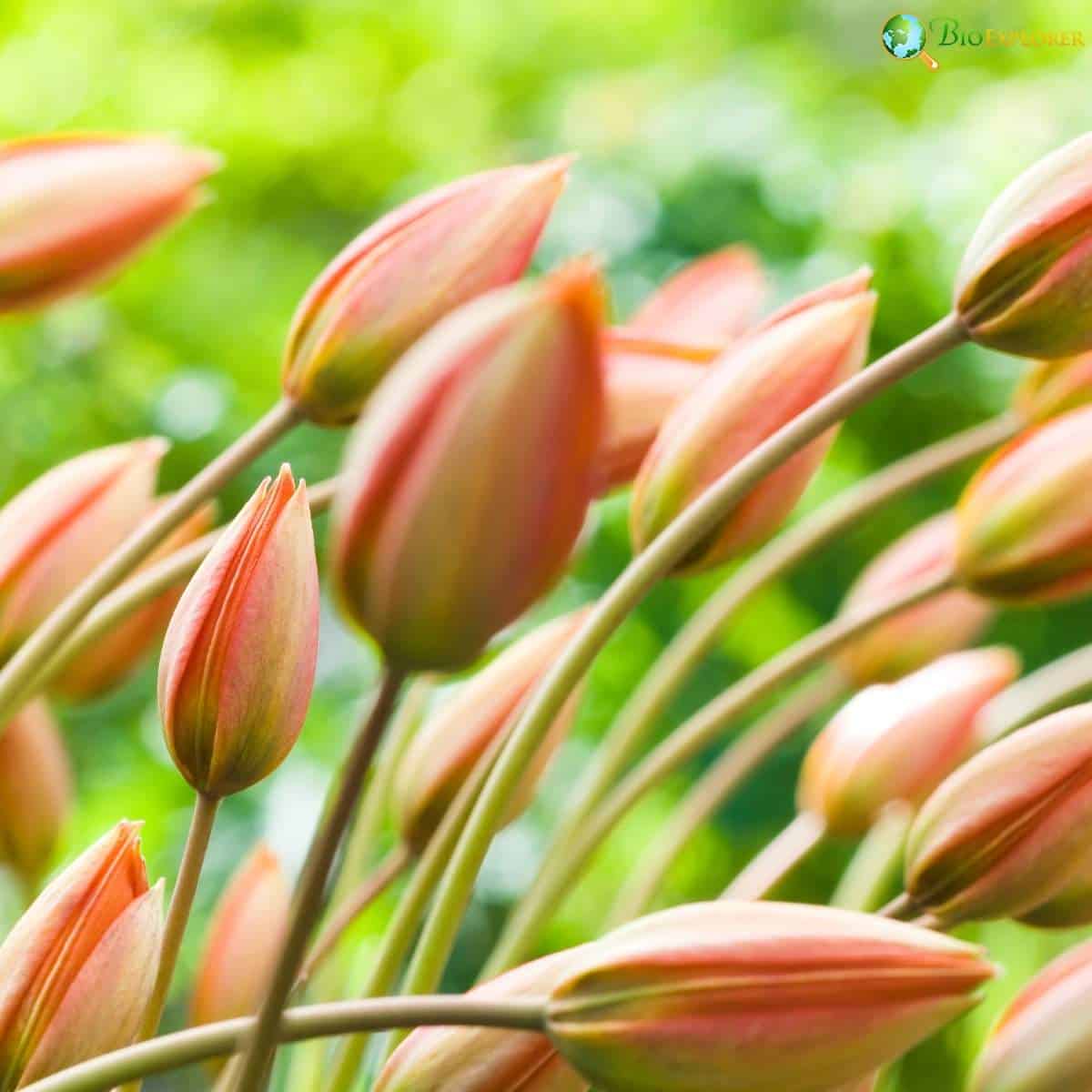
Tulipa orphanidea, commonly known as the Greek Tulip, is a charming species of tulip native to southeastern Europe, particularly Greece and Turkey. This elegant wildflower brings Mediterranean beauty to spring gardens with its delicate form and warm coloration.
Colors available: Orange-yellow with a bronze or reddish exterior, though color can vary from pale yellow to deep orange-red.
Fun facts:
- Tulipa orphanidea is named after the Greek botanist Theodoros Georgios Orphanides, who first described the species in the 19th century[10].
- In its native habitat, this tulip grows on rocky slopes and in mountain meadows.
- The flowers have a slight fragrance, which is unusual for wild tulips.
- Tulipa orphanidea is sometimes called the “Late Tulip” because it blooms later than many other species.
- This tulip is known for its elegant, elongated flower shape, often urn-shaped or goblet-shaped.
16. Rembrandt Tulips
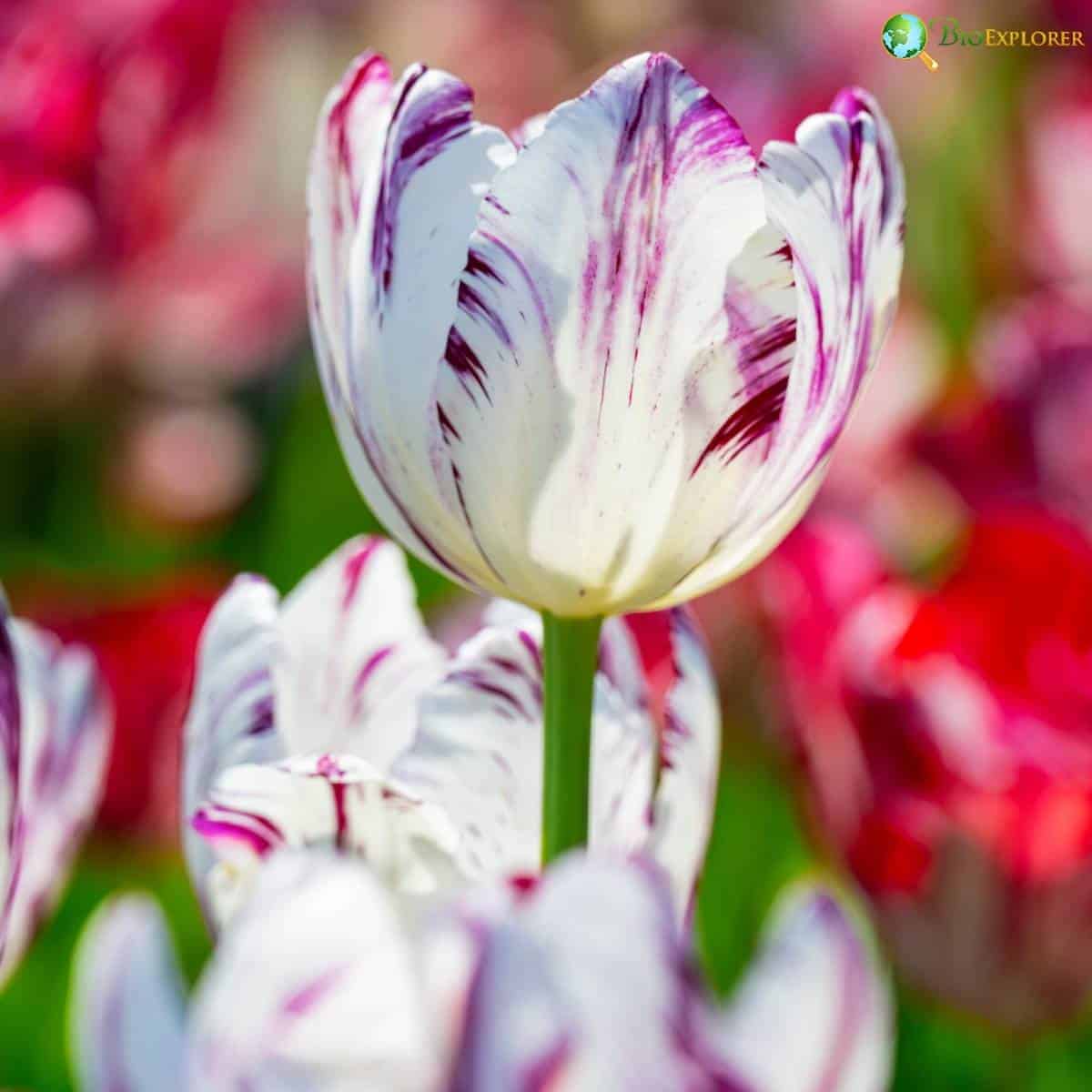
Rembrandt Tulips are not a specific species or cultivar but a group of tulips characterized by their distinctive flame-like streaks and feathering on the petals. Named after the Dutch painter Rembrandt van Rijn, these tulips bring a touch of artistic flair to spring gardens with their unique coloration and patterns.
Colors available: Rembrandt Tulips come in various color combinations, typically featuring a base color with contrasting streaks or feathers. Common combinations include red and white, purple and white, and pink and yellow.
Fun facts:
- The original Rembrandt Tulips were caused by a mosaic virus that created the striking color breaks and patterns. However, modern Rembrandt-style tulips are bred to mimic this look without the harmful virus.
- During the Dutch Golden Age in the 17th century, Rembrandt Tulips were highly prized and played a significant role in the famous “Tulip Mania” economic bubble[11].
- True virus-infected Rembrandt Tulips are now rare and protected. What we call Rembrandt Tulips today are carefully bred varieties replicating the broken color effect.
- Dutch Golden Age artists, including Rembrandt, often featured these tulips in still-life paintings.
- The unpredictable nature of the original virus-infected tulips meant that no two flowers were exactly alike, adding to their allure and value.
17. Tulipa saxatilis (Cretan Tulip)
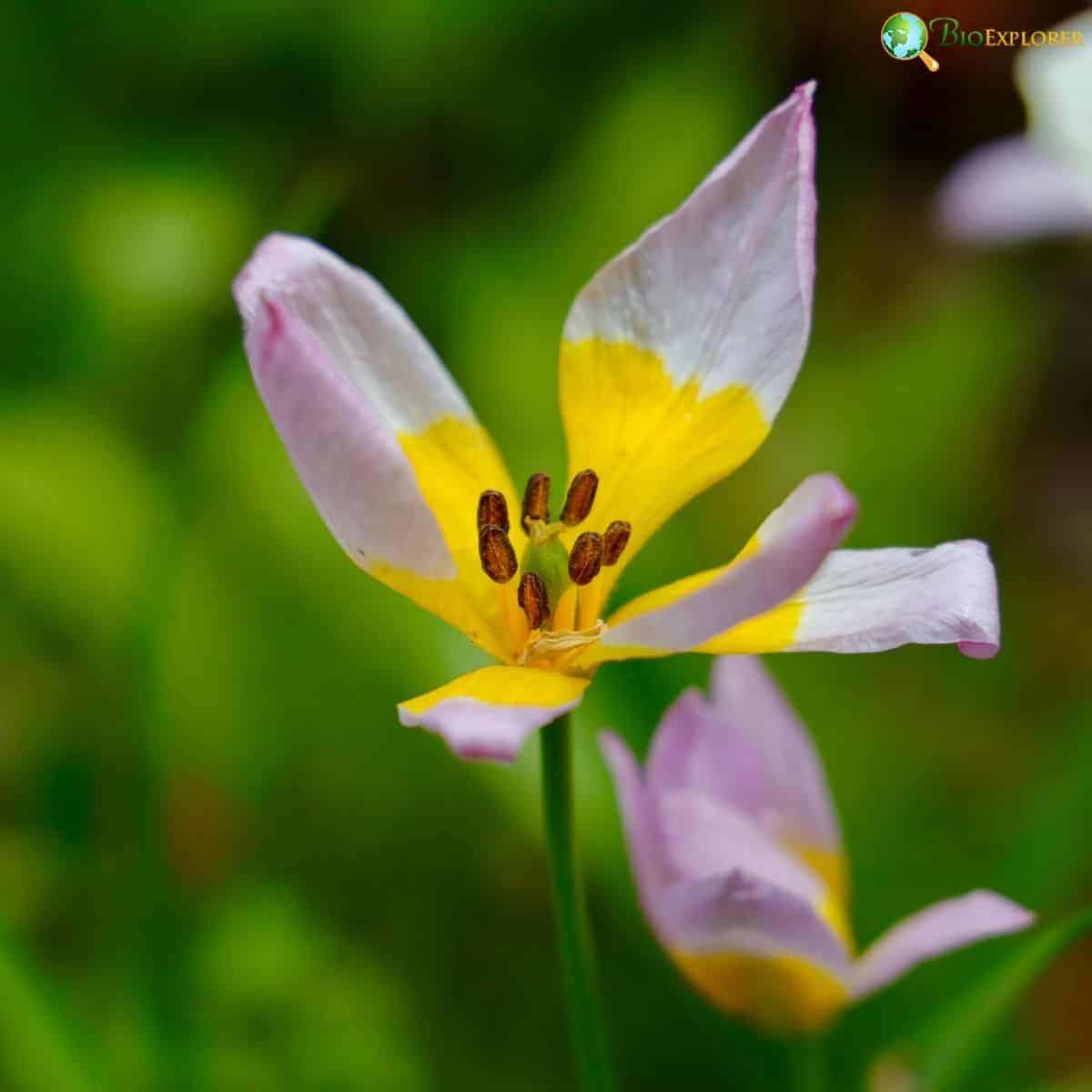
Tulipa saxatilis, commonly known as the Cretan Tulip or Rock Tulip, is a charming species of tulip native to the eastern Mediterranean, particularly the island of Crete. This delightful wildflower brings natural beauty to spring gardens with its star-shaped blooms and naturalizing ability.
Colors available: A soft Lilac-pink with a bright yellow center, though the intensity of the pink can vary.
Fun facts:
- The species name “saxatilis” means “dwelling among rocks, ” referring to its natural habitat in rocky areas of Crete and nearby regions.
- Unlike many tulips, Tulipa saxatilis has a sweet, light fragrance, especially noticeable on warm, sunny days[12].
- Each bulb can produce multiple flower stems, creating a more abundant display than larger tulips.
- Tulipa saxatilis is one of the few tulip species that can thrive in partial shade, making it suitable for woodland garden settings.
- The flowers open wide in sunlight, forming perfect stars, which gives it another common name: the Starry Tulip.
- This tulip is known for its excellent naturalizing ability, spreading slowly to form attractive colonies in suitable conditions.
18. Peach Blossom (Tulipa ‘Peach Blossom’)
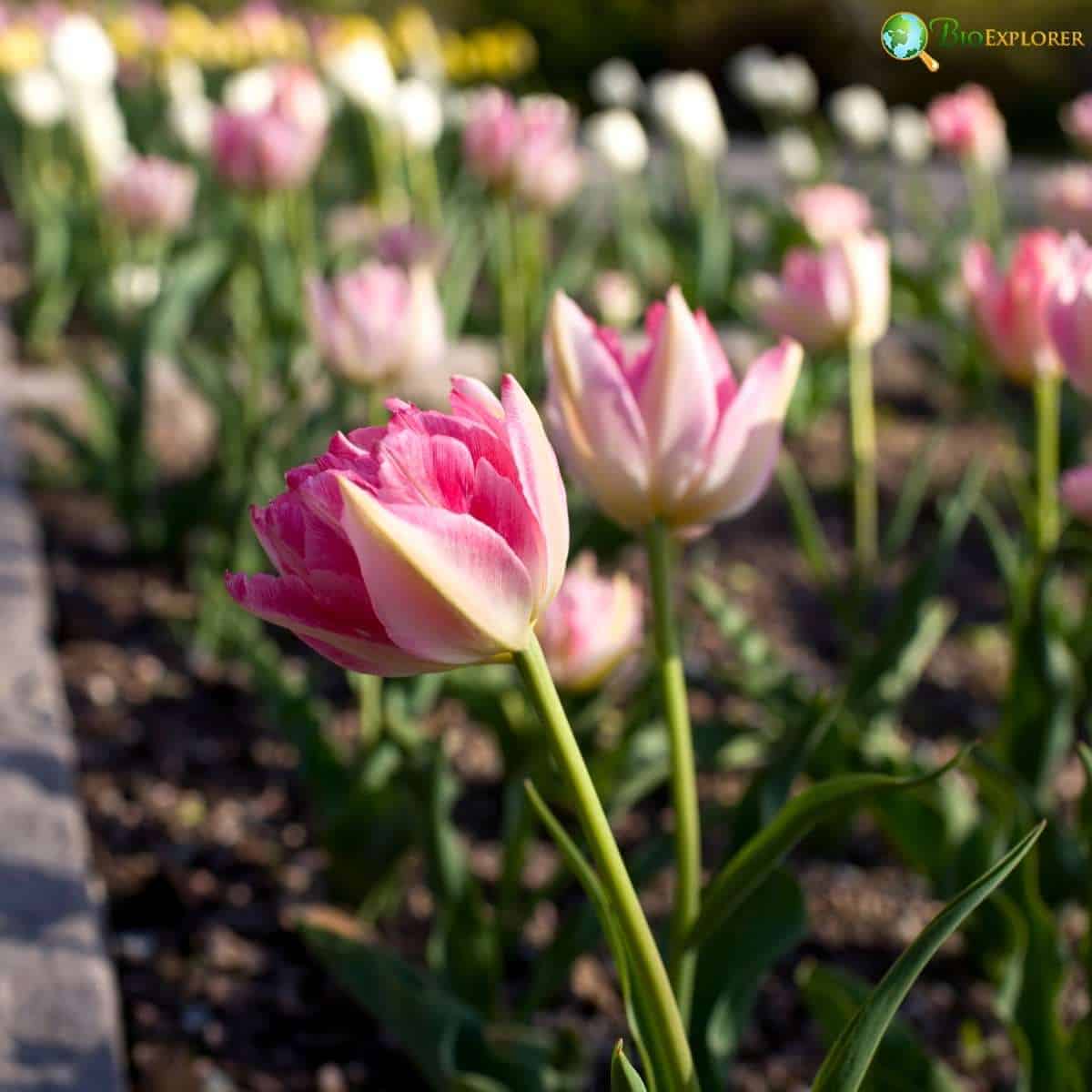
Peach Blossom is a charming double early tulip known for its full, peony-like blooms and soft, romantic coloration. This hybrid tulip brings delicate beauty to spring gardens with its lush flowers and compact growth habit.
Colors available: Soft pink petals with a pale peach undertone, sometimes deepening to a rosier pink at the edges.
Fun facts:
- Peach Blossom tulips are part of the Double Early group, which means they bloom earlier than many other double tulips and have a more compact form.
- The flowers have up to 30 petals per bloom, giving them a full, fluffy appearance similar to a small peony.
- This Peach tulip variety was first introduced in 1890, making it a relatively old cultivar that has stood the test of time.
- Peach Blossom tulips are excellent for forcing indoors, allowing gardeners to enjoy their beauty even before spring arrives outside.
- The soft coloration of Peach Blossom tulips makes them particularly effective in moon gardens or white-themed gardens, where they add a hint of warmth without disrupting the overall palette.
- These tulips are known for their sturdy stems, which help them stand up to spring rains better than some double varieties.
19. Tulipa praestans (Fire Tulip)
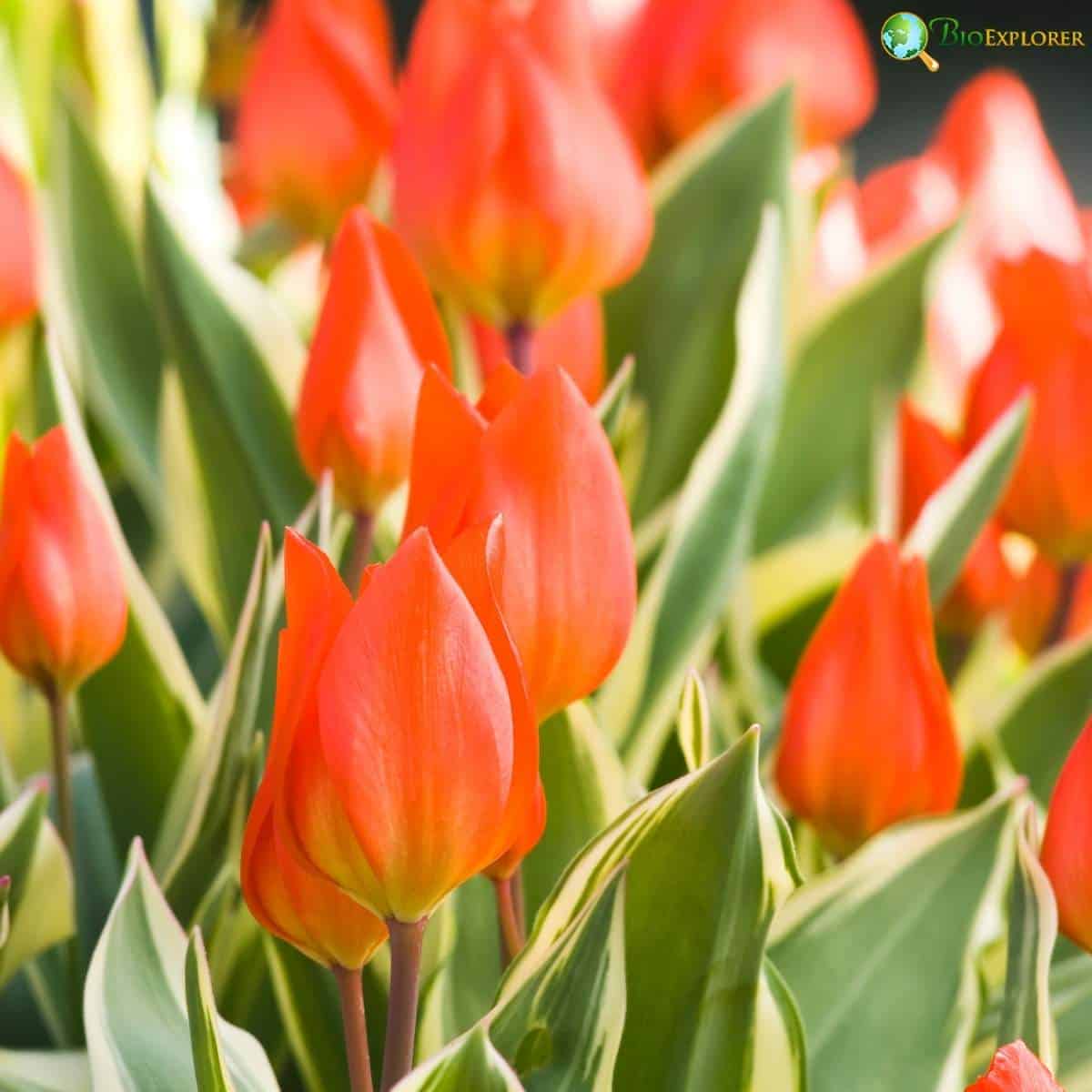
Tulipa praestans, commonly known as the Fire Tulip or Early Emperor Tulip, is a vibrant species of tulip native to Central Asia. This striking wildflower brings intense color to early spring gardens with its clusters of bright flowers[13].
Colors available: A vivid scarlet-red, though some cultivars can range from orange-red to deep crimson.
Fun facts:
- The species name “praestans” means “outstanding” or “excelling, ” which aptly describes its bold appearance and reliable performance in gardens.
- Unlike many tulips that produce a single flower per stem, Tulipa praestans often produce multiple flowers on each stem, creating a more abundant display.
- This tulip is one of the earliest to bloom in spring, often flowering alongside crocuses and early daffodils.
- Tulipa praestans is known for its excellent naturalizing ability, spreading slowly over time to form attractive colonies in suitable conditions.
- The leaves of Tulipa praestans are distinctive, being broader and more strap-like than those of many other tulip species.
- This species is more resistant to tulip fire disease than many other tulips, making it a good choice for gardeners who have struggled with this problem.
20. Apricot Beauty (Tulipa ‘Apricot Beauty’)
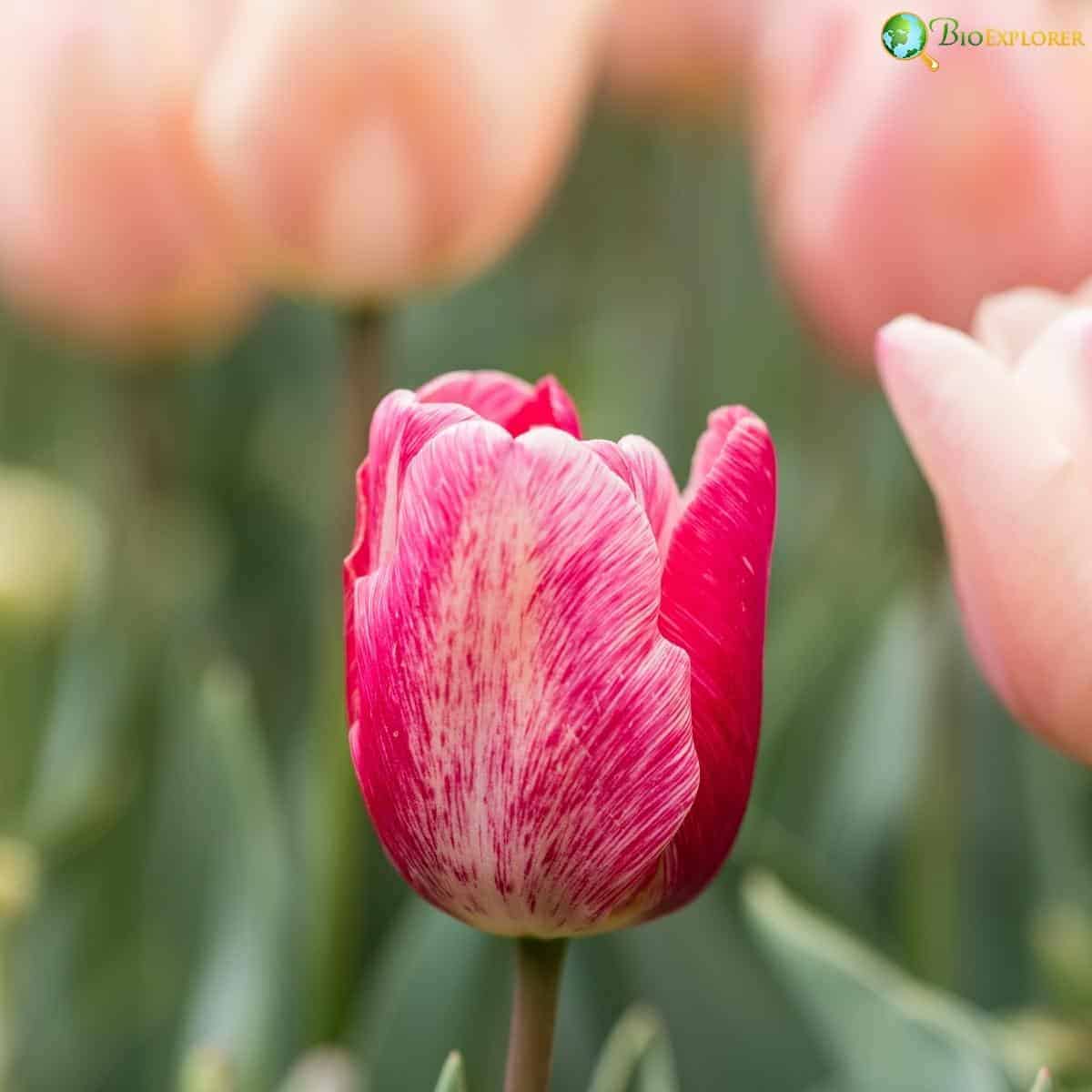
Apricot Beauty is a stunning single early tulip known for its soft, warm coloration and elegant form. This hybrid tulip brings a touch of subtle sophistication to spring gardens with its delicate hues and reliable blooming habit.
Colors available: Soft apricot-pink, often with a deeper Rose blush on the outer petals. The color can vary slightly depending on growing conditions, sometimes appearing more peachy or pink.
Fun facts:
- Apricot Beauty was first introduced in 1953 and has remained popular thanks to its unique color and versatile nature.
- As a single early tulip, it’s one of the first to bloom in spring, often flowering alongside early daffodils.
- The flowers have a slight fragrance, which is unusual for tulips and adds to their appeal.
- Apricot Beauty is known for its excellent forcing ability, making it a popular choice for indoor winter blooms.
- The soft coloration of this tulip makes it particularly effective in pastel-themed gardens or as a complement to bolder, more vibrant tulip varieties.
- In cooler weather, the apricot tones of the petals can deepen, creating a beautiful ombre effect from base to tip.
21. Black Hero (Tulipa ‘Black Hero’)
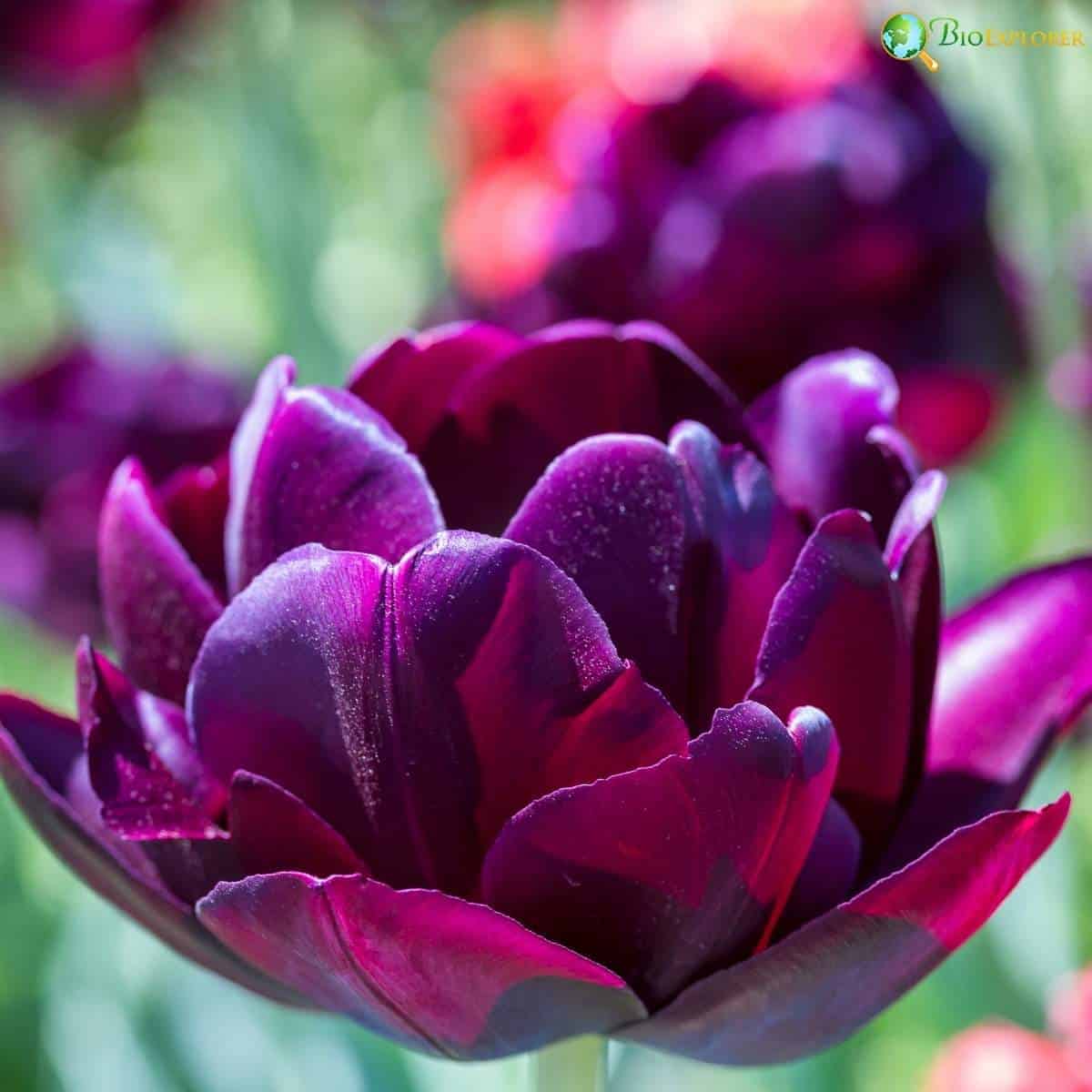
Black Hero is a striking double late tulip known for its deep, dramatic coloration and full, peony-like blooms. This hybrid tulip brings a touch of mystery and sophistication to late spring gardens with its unusually Dark Flowers.
Colors available: Deep purple, so dark it appears almost black, especially in low light conditions.
Fun facts:
- Black Hero is a sport (natural mutation) of the popular ‘Queen of Night’ tulip, sharing its deep coloration but with double flowers.
- As a double late tulip, it blooms towards the end of the tulip season, often lasting well into May in many regions.
- Each flower can have up to 30 petals, creating a lush, full bloom that resembles a peony.
- Despite its name, the color is a very deep purple, not truly black. You can sometimes see a slight sheen or undertone to the petals in bright sunlight.
- Black Hero tulips are excellent for cutting, lasting up to 10 days in a vase, and creating dramatic floral arrangements.
- The dark flowers of Black Hero can appear to “glow” in twilight gardens, creating an enchanting effect as daylight fades.
22. Tulipa linifolia (Flax-leaved Tulip)
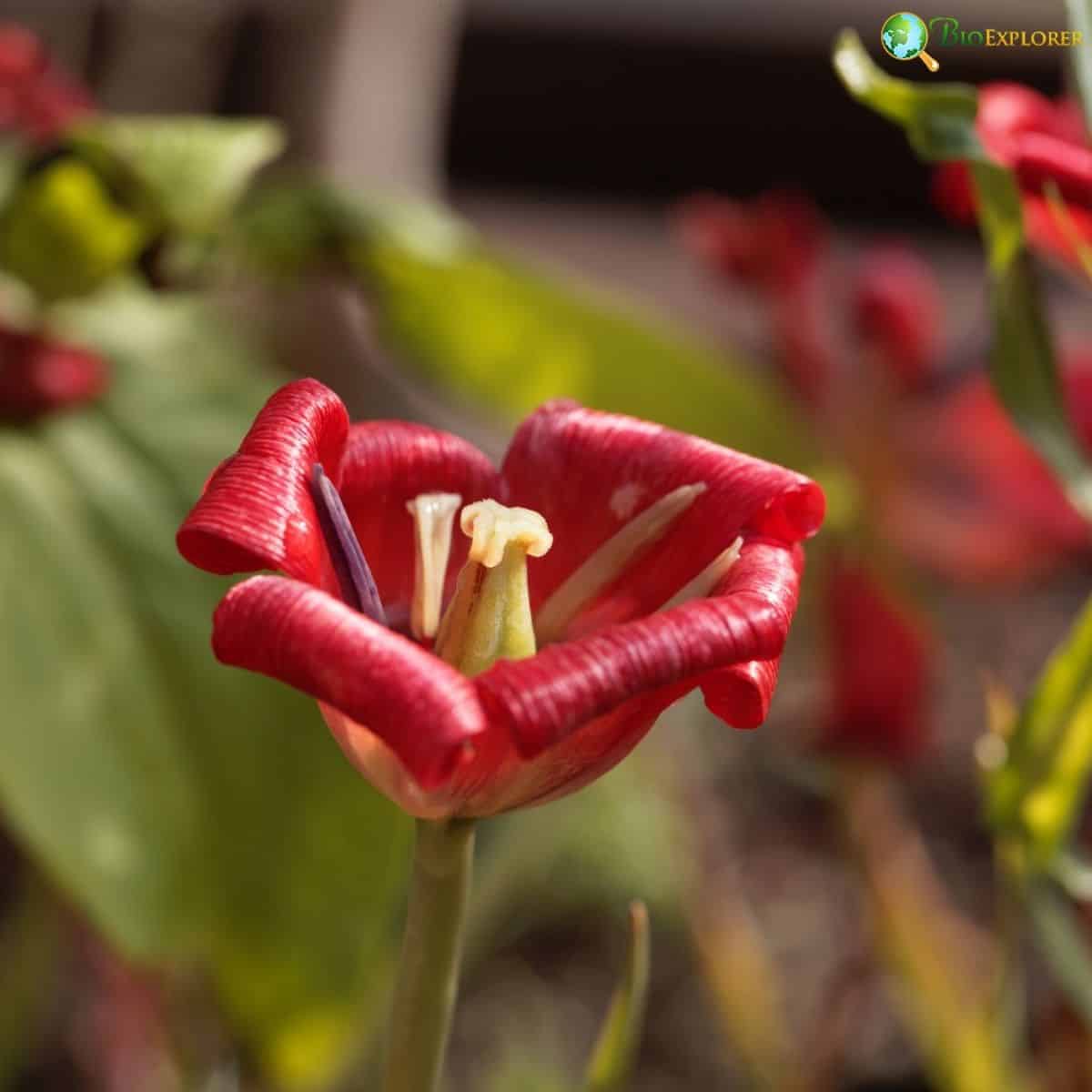
Tulipa linifolia, commonly known as the Flax-leaved Tulip or Bokhara Tulip, is a charming tulip native to Central Asia. This petite wildflower brings vibrant color to spring gardens with its bright blooms and distinctive foliage.
Colors available: A brilliant scarlet-red with a black base, though some forms may have a yellow center.
Fun facts:
- The species name “linifolia” refers to its leaves, which are narrow and grass-like, resembling those of the flax plant.
- Tulipa linifolia is one of the smallest tulip species, typically growing only 4-6 inches (10-15 cm) tall.
- Despite its small size, the flowers are proportionally large and open wide in full sun, creating a striking display.
- This tulip is known for its ability to naturalize in suitable conditions, spreading slowly to form attractive colonies over time.
- The flowers are distinctive, opening nearly flat in full sun to reveal a star-like form.
- Tulipa linifolia is part of the Botanical Tulip group, which includes species of tulips and their close hybrids, prized for their wild, natural appearance.
23. Tulipa schrenkii
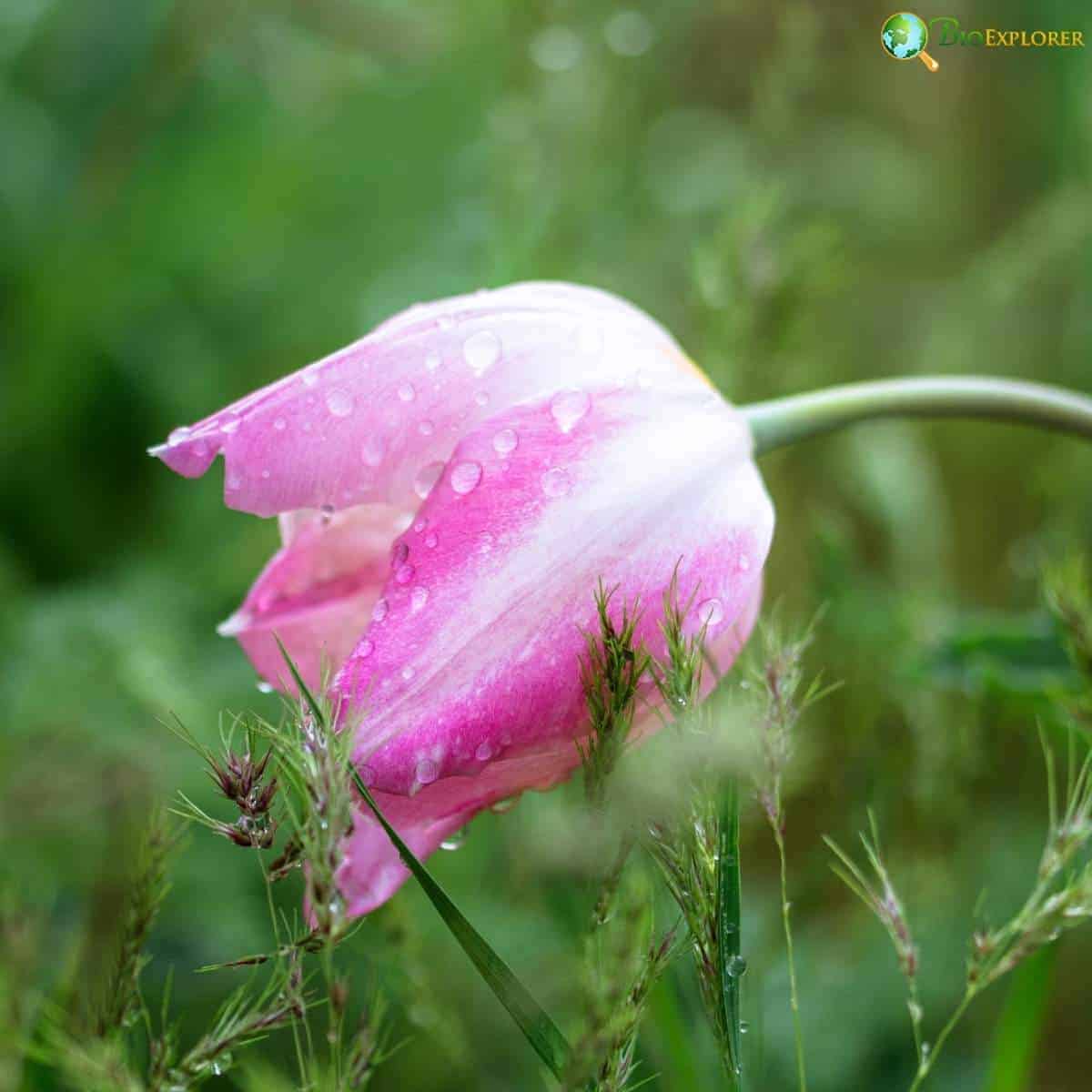
Tulipa schrenkii, sometimes called Schrenk’s Tulip, is a striking species of tulip native to parts of Eastern Europe and Central Asia. This wildflower brings a touch of natural elegance to spring gardens with its vibrant colors and classic tulip shape.
Colors available: Typically red with yellow edges, though the color can vary from deep crimson to bright scarlet, sometimes with a yellow base.
Fun facts:
- Tulipa schrenkii is named after Alexander von Schrenk, a 19th-century Baltic German naturalist who explored Central Asia[14].
- This tulip species is one of the ancestors of many modern garden tulips, contributing to their vibrant colors and hardy nature.
- In its native habitat, Tulipa schrenkii can be found growing in steppes and on dry, rocky hillsides.
- The flowers have a distinctive goblet or cup shape, opening wide in full sun to reveal their colorful interior.
- Tulipa schrenkii is known for its early blooming habit, often one of the first tulips to flower in spring.
- This species is more tolerant of heat and drought than many hybrid tulips, making it suitable for warmer or drier garden conditions.
24. Tulipa biebersteiniana
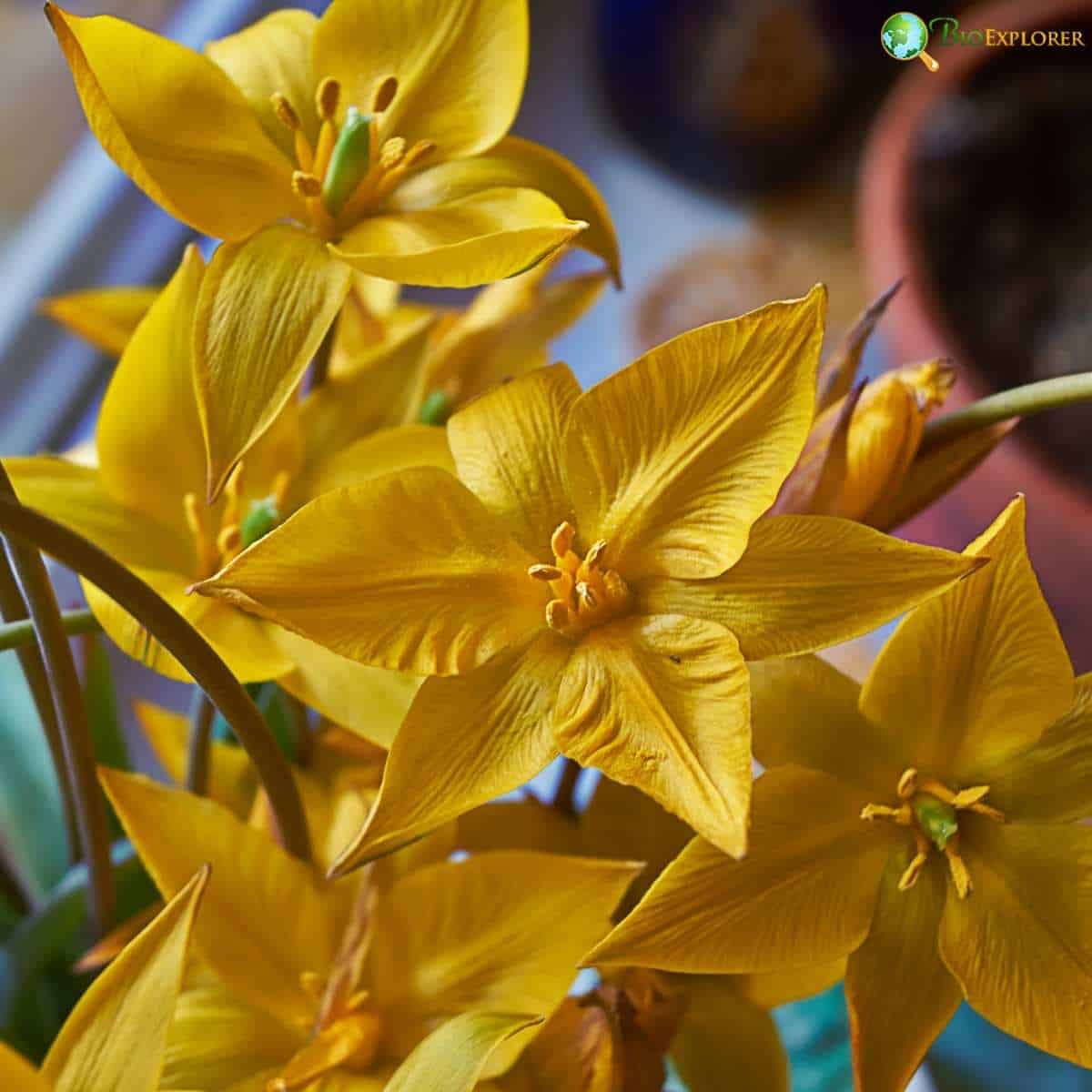
Tulipa biebersteiniana, sometimes called Bieberstein’s Tulip, is a delightful tulip native to parts of Eastern Europe and Western Asia. This charming wildflower brings a splash of cheerful color to spring gardens with its star-shaped blooms and naturalizing tendency[15].
Colors available: Bright yellow, though some forms may have a slight greenish or bronzy tinge on the outer petals.
Fun facts:
- The species is named after Friedrich August Marschall von Bieberstein, a German botanist and explorer who studied the flora of the Caucasus region in the early 19th century.
- Tulipa biebersteiniana is one of the few tulip species that can thrive in partial shade, making it suitable for woodland garden settings.
- When fully open, the flowers have a distinctive star shape, with pointed petals that spread wide in sunlight.
- This tulip is known for its excellent naturalizing ability, spreading slowly to form attractive colonies in suitable conditions.
- Unlike many tulips, Tulipa biebersteiniana often produces multiple flowers per stem, creating a more abundant display.
- The leaves of this species are narrow and grass-like, adding to its wild, natural appearance in the garden.
25. Tulipa turkestanica
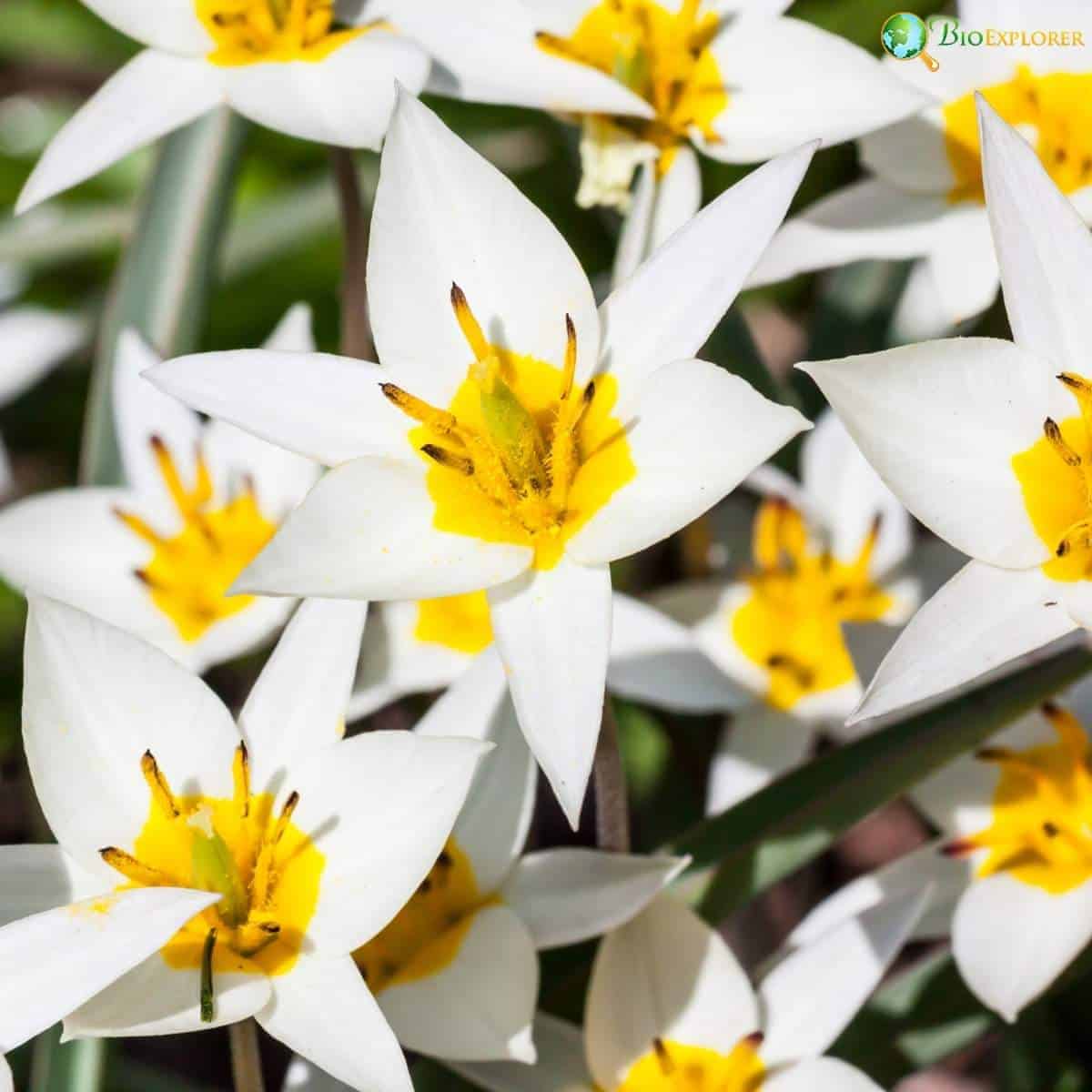
Tulipa turkestanica, also known as the Turkestan Tulip, is a charming tulip native to Central Asia. This diminutive wildflower brings delicate beauty to spring gardens with its clusters of star-shaped blooms and naturalizing habit.
Colors available: White with a yellow center, though the outer petals may have a pinkish or greenish tinge.
Fun facts:
- Tulipa turkestanica is named after Turkestan, a historical Central Asian region where it naturally occurs.
- Unlike many tulips that produce a single flower per stem, this species can produce up to 12 flowers on each stem, creating a bouquet-like effect.
- The flowers have a sweet, honey-like fragrance, which is unusual for tulips and adds to their appeal.
- Tulipa turkestanica is one of the earliest tulips to bloom in spring, often flowering alongside crocuses and early daffodils.
- This species is known for its excellent naturalizing ability, spreading slowly over time to form attractive colonies in suitable conditions.
- The leaves of Tulipa turkestanica are narrow and slightly wavy, adding to their ornamental[16] value even before the flowers appear.
Colorful tulips are a cornerstone of spring gardening, offering an unparalleled range of hues, forms, and sizes to suit any garden style or personal preference. From the deep, mysterious purples of ‘Queen of Night’ to the cheerful yellows of Tulipa tarda, and from the elegant simplicity of species tulips to the flamboyant ruffles of parrot varieties, there’s a tulip for every taste and purpose.
So, embrace the rainbow of possibilities that tulips offer. Let their colors paint your garden with spring hues, and enjoy the unfolding spectacle as these beloved flowers emerge each year, bringing with them the promise of warmer days and the sheer delight of nature’s beauty.
Cite this page
Bio Explorer. (2026, January 1). Top 25 Colorful Tulips: A Rainbow in Your Garden. https://www.bioexplorer.net/colorful-tulips.html/




